Update: Sadly, we put this trip on hold in mid-February 2020 as we embraced the reality of the breadth and depth of Covid 19. We are grateful to all of the vendors mentioned here who were gracious and cooperative as they helped us with our cancellations. For many of them, the travel industry has been their family’s livelihood for multiple generations. We offer continued prayers for their well-being during this pandemic and monumental success for their businesses when we are once more free to travel and discover the new normal together.
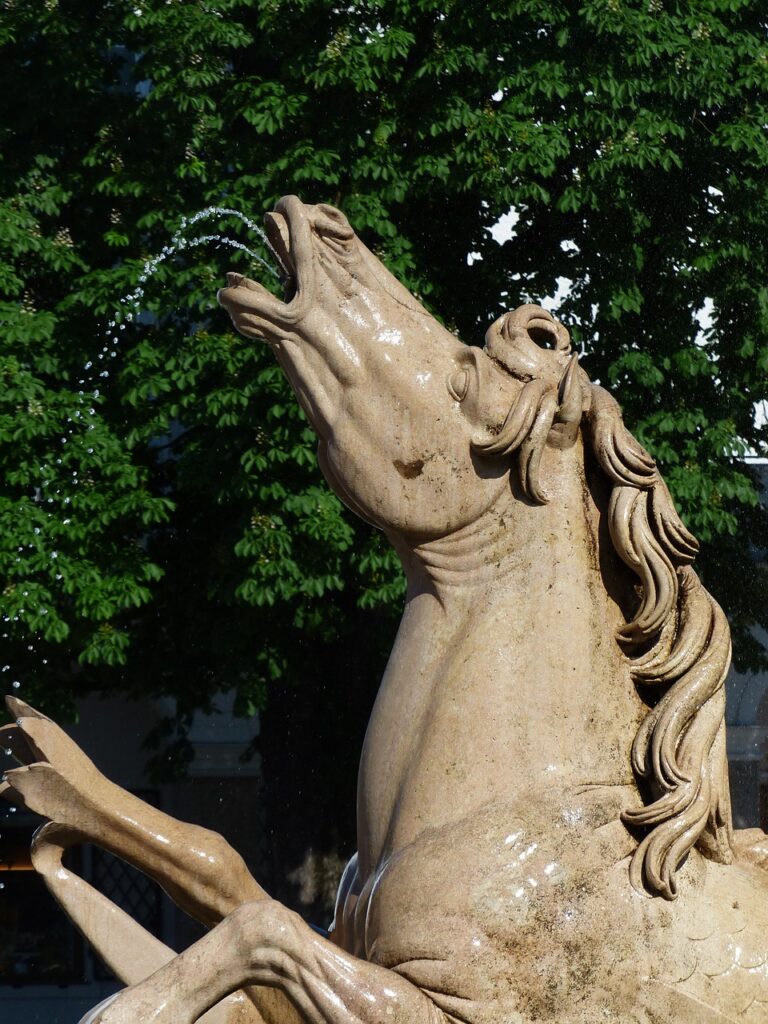
Are you leery of those BIG BUS travel tours that speed from one destination to the next and a new hotel each night?
Many tour companies seem more focused on packing their coaches full of warm bodies to make a profit rather than providing their customers with an authentic travel experience.
If you’re willing to move a bit out of your comfort zone, you can plan your own customized European “adventure.” This Do It Yourself (DIY) 14-day travel route through eight countries aims to remove the guesswork, limit travel time, reduce cost, and maximize the golden moments as it allows you to be in control of the journey.
Our Experience with BIG BUS Tours
As a couple, we’ve taken two of those BIG BUS tours to different destinations arranged by popular travel companies. We vowed the first time we’d never do it again, relented, and made the same mistake twice.
We spent long hours each day on the coach in our small assigned space, never reclining our “luxury” seats as a courtesy to the couple behind us. With 50 or more travelers on each trip, we stood in line for almost everything. We waited in long queues to see exhibits, buy coffee or a quick lunch, use the toilet, and even to retrieve our luggage many afternoons.
Furthermore, we often felt rushed through each attraction and wished we had another hour or two to explore the destination. And, with a new hotel stop nearly every night, just as we were acclimating ourselves to our new surroundings in the evening, we were on the coach again early the next morning, speeding toward the next stop.

We’re usually the first to embrace diversity and true, we made new friends. However, because of the significant difference in age and background of 50 people, all with varying patience levels and needs,–don’t be offended, diversity is sometimes overrated.
After 15 happy trips with traditional college-age students as the target audience, we’re looking forward to our upcoming Great Big European Road Trip exclusively for an over 60 crowd. Our group consists of twelve family members and friends, all willing to trust that we know what we’re doing. Of our planned stops, we’ve never been to the cities of Bled, Padua, and only driven through Zurich, but part of the adventure is figuring it all out as we move along.
This post’s primary purpose is to provide an overview of the trip for the 10 people who will be traveling with us in a few months. The following information maps out our travel route featuring a number of places we’ve seen before and we’re looking forward to seeing again.
However, in light of the possibility that Google sends other curious readers to this site, this post may provide helpful information for those interested in planning their own Do It Yourself trip.
If you’re a prospective Do It Yourselfer, scroll down for suggestions for hotels and transportation sources, links to sites and services, and tips for curbing costs. Learn from our experiences, good and bad, as you create your own journey through some of the most intriguing destinations in Europe.
It initially took some courage, but researching and arranging our own unique travel routes has challenged our thinking, whetted our curiosity for learning, and enhanced our enthusiasm and energy for living. We never end one journey without mentally mapping out the next.
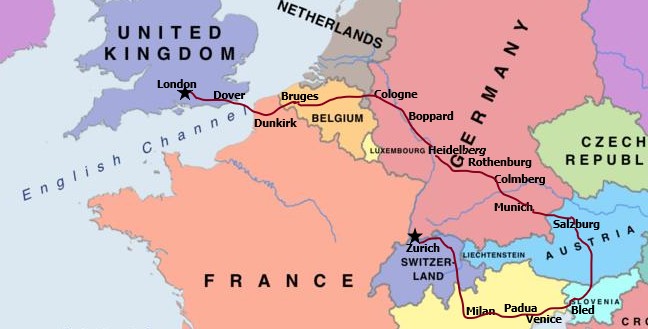
This trip’s highlights:
- Two nights in Maritime Greenwich, which joined the ranks of UNESCO World Heritage Sites in 1997
- Narrated Thames River Cruise
- The Tower of London, also a UNESCO World Heritage Site
- Dover Castle
- An optional hike on Dover’s White Cliffs to South Foreland Lighthouse
- One night in Dover
- Passage across the English Channel via PO ferries.
- A lunch-time stop in Dunkirk/French Flanders and the Beffroi de St. Eloi, a UNESCO World Heritage Site
- Two nights/one day in the UNESCO inscribed city of Bruges, Belgium
- The American Cemetery in Margraten, Netherlands
- Cologne Cathedral–world’s largest facade and third tallest spires, and also a UNESCO World Heritage Site
- One night in Boppard, Germany, along the Rhine River
- Passage on a Rhine River Cruise between Boppard and Bacharach through the Rhine Gorge, a UNESCO World Heritage Site
- Afternoon stop in Heidelberg, Germany
- Supper in Rothenberg, Germany, at Zur Holle
- One night in a 13th century castle in the Bavarian Alps with lots of strange taxidermy
- A lunch-time stop in Munich
- Two nights/one day in Salzburg, Austria, in Old Town, recognized as a UNESCO World Heritage Site
- Passage through the Julian Alps and a lunch-time stop on Lake Bled in Slovenia
- Two nights/one day in Padua, Italy–or Venice via a 25 minute high speed train ride
- Scenic six-hour train journey from Padua to Zurich through Gotthard Pass and the heart of the Swiss Alps
- Two nights/one day in Zurich, Switzerland
- Options to see additional UNESCO World Heritage Sites in London, Greenwich, Salzburg, Venice, and Padua
DIY Tip #1: The best flight experience meets the following criteria:
- Book a flight that arrives at your European destination in the late evening rather than the next morning.
- Book a returning flight to the United States that allows at least three hours to move through customs, clear security, and catch your connecting flight home.
Most flights to Europe involve a late afternoon departure and an overnight flight selling the premise that you’ll sleep on the plane. Truth be told, you’ll get little sleep despite your best efforts. You’ll arrive at your destination early in the morning, bleary-eyed with atrocious breath and disheveled hair, disoriented by the time change and culture. Furthermore, it’s unlikely you’ll be able to check into a hotel before 3 in the afternoon, so you’ll wander about in a stupor and retain little memory of your first day of the trip. These flights are not for members of the over-60 crowd.
The last four trips we’ve taken to Europe began on an American Airlines flight out of Kansas City at 5:45 am with an estimated arrival in London at 10:45 pm. And, for this upcoming trip, we were even happier to discover that a flight with the the same time scenario departs from Wichita, Kansas for about $100 cheaper. Both flights have layovers in Chicago where travelers board for the international flight. In my short investigation, American Airlines is the only major airline that offers this flight timeline out of the Midwest to London, but I’m confident similar flights must exist departing from major cities across the East Coast .
DIY Tip #2: Find a reliable London airport transfer on Google.
We’ve had good luck with every London transfer company we’ve used. I searched online, scrutinized the customer reviews, and encountered only the most professional customer service in email transactions and upon our arrival.
To avoid confusion, always communicate afternoon arrivals and departures in military time, for example, 18:00 rather than 6:00 pm.
Day One: Arrival in Greenwich, England–Our Comfort Zone
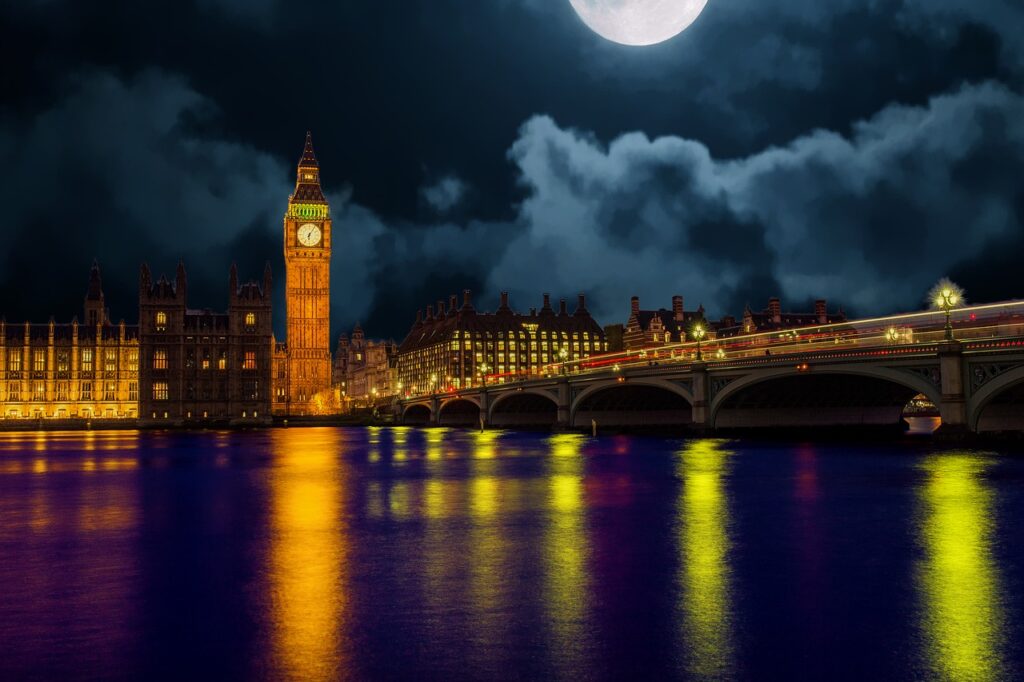
After our arrival in London that evening at approximately 10:45 pm, we’ll get a glimpse of the city by moonlight as our chartered minibus whisks us across the River Thames to our hotel in Greenwich. We’ll arrive around midnight.
We’re biased when it comes to Greenwich. We discovered it five trips ago and it’s quickly become our favorite London neighborhood. Greenwich has more affordable hotels and we’ll avoid rush-hour traffic when we head to Dover on Thursday. With only one day to see London’s highlights, maneuvering the city is much simpler from a Greenwich vantage point–added bonus, there are key attractions in Greenwich, too. In fact, we are staying in the heart of Maritime Greenwich, inscribed by UNESCO as a World Heritage Site in 1997 for its contribution since the 17th century, to the studies of astronomical and navigational research.
The Innkeeper’s Lodge, The Greenwich Mitre
London and Zurich, two of our destinations, are among the world’s most expensive cities for tourists. It’s not uncommon for a mediocre central London hotel room to cost $500 or more per night during the shoulder season of April and May–and even more during the summer.
In fact, finding a hotel room in London that merits the money spent–even in the spring–has been the hardest task of this trip’s planning process.
Out of respect for the establishment, I won’t mention the newer Greenwich hotel where we’ve stayed in the past. The manager offered us rooms for our upcoming trip for over $300 per room per night. The rooms are spartan–much like the low-end budget hotels in the United States. The beds are hard, breakfast is high-carb with mammoth-sized croissants pumped full of chocolate, and a disorienting millennial vibe permeates the entire hotel. In low season when we always traveled, the rooms are only $120 a night. We don’t feel the same room is worth $300 when we arrive closer to the high season, however.
So, after much trepidation, it seems the better choice for our budget is an “old” hotel and pub, recently renovated, that’s found its way on Google Maps since 2016. Not only is it a bit more affordable at a little over half the price, it’s only a two block walk from the Greenwich Pier. In addition, we’ve requested a full English breakfast be included with our room—get ready for some British baked beans and your first taste of marvelous marmolite. I’m happy to note the recent Trivago, and Google reviews of this hotel are more favorable than those for our previous hotel and mention comfortable beds.

Our hotel, the Greenwich Mitre is nearly three centuries old and the pub below is now recognized as a a component of the UNESCO recognized Maritime Greenwich. This property has been acquired by the reputable Innkeeper’s Lodge chain which apparently buys up and renovates old pubs and coaching inns, promising rooms “bursting with character” and “all creature comforts and modern facilities.” Those who renovate historic properties are required to retain as much of the original character as possible and it’s likely this hotel will be a little quirky–odd-sized rooms, antiquated-looking bathroom fixtures, an eclectic mix of furniture, and flights of creaky stairs. Fortunately, the rooms are en suite–so, there’ll be no “hairy buttocks” surprises like we’ve experienced other places and, by many reports, this hotel will have the “quaint English charm” that our previous hotel doesn’t have. Even better, staying at this hotel for two nights may produce a good story or two that you can share with your friends back home.
Day Two, Our Day in London
In addition to its iconic images etched in our heads since childhood, London has over 50 museums and many are free. Other museums, some rather quirky, have a minimal charge. This makes decision-making all the more difficult when there is only one travel day to explore one of the largest cities in the world.
At least six noteworthy attractions lie within three blocks walking distance from our hotel in Greenwich. The National Maritime Museum and the 17th century Queen’s House have free admission. The Royal Observatory, the Cutty Sark, and the Painted Hall each charge a minimal fee. Greenwich Market and Discover Greenwich, the city’s visitor center are also worthwhile destinations, but like nearly every London museum or attraction, none of these noted sites open until 10:00 am and all close at 5:00 pm.
For that reason, it’s best to leave Greenwich at 9 or 9:30 am to arrive in the heart of London just as its attractions are opening. Then, if there are sites in Greenwich you wish to visit, plan on a mid-afternoon return from London centre at 2 or 2:30 pm to allow time to enjoy at least one attraction.
DIY Tip #3: Three Reliable Ways to Travel to London from Greenwich
- Currently a London travel card costs GBP 12.70 (about $16) for use all day on any subway or bus in districts 1 and 2 which includes Greenwich.
- A round trip on the Thames Clipper/ River Roamer for GBP 17.80 (about $24) allows hop-on and off access from approximately 6:00 am until 22:00 (10:00 pm) between the center of London and Greenwich.
- City Cruises boats are also an option for a similar round-trip cost, but the timetable is limited. These boats don’t provide service from Greenwich until 10:30 am and the last boat returning to Greenwich departs from Westminster Bridge in London’s City Center at 16:00 (4:00 pm.)
Travel by DLR and London’s Underground

The Dockland Light Rail (DLR) and, in turn, London’s underground or subway system are easy to navigate from Greenwich and all over London, for that matter.
- Walk the 1.5 blocks from our Greenwich hotel to the Cutty Sark DLR station.
- Travel to Bow Church Station from Cutty Sark.
- Transfer to the Bow Road Subway Station
- Select an inward bound on the District Line to Embankment or the Westminster Subway Stations.
Travel to the Center of London on River Roamer or City Cruises

Although purchasing a travel card for London’s light rail and underground provides you with low cost transportation on its entire network of stations, traveling to the center of London from Greenwich is easier by the Thames Clipper/ River Roamer or a City Cruises boat.
The Greenwich Pier is approximately two blocks from our hotel.
These cruises allow you sit and enjoy the boat ride from Greenwich to Westminster Pier with stops along the way–there’s even a coffee and snack bar on each boat. Check departure times for the Thames Clipper/River Rover and allow at least an hour travel time. Likewise, consult City Cruises and allow at least an hour and 15 minutes.
The Changing of the Guard
When we’ve traveled with other people, it seems the bucket list attraction is the Changing of the Guard. We’ve given considerable thought to our limited time in London, and short of saying this time-honored event is overrated, the mid-day timing means missing so many other sites of interest.

However, if viewing the Changing of the Guard is a dying wish, you’ll need to take either the subway or a riverboat to arrive at Buckingham Palace for a good “standing spot” before 10:30 am.
You can easily access the Docklands Light Rail to the subway from our hotel. Travel it to Embankment or Westminster subway stations. You can also take the Thames Clipper/ River Rover to Westminster Pier.
Buckingham Palace is approximately half a mile walk from Westminster Pier/Westminster subway station via Birdcage Walk. Or, if you can afford more time, 7/10 of a mile from Trafalgar Square via the Admiralty Arch and Mall Road. Often, the Queen’s Horse Guard has passed us on its way to the palace on this second route.
Please note, if your free day falls on a Tuesday, Thursday, or Saturday, this event is not an option. (Check the schedule shortly before arrival, but this event traditionally occurs on M, W, and F from 10:45 to 11:30 am, for as long as we have traveled to London. )
Make Trafalgar Square Your Starting Point in London Center
Trafalgar Square is a busy meeting place in the center of London and about a two-block walk from Westminster Pier or Westminster Subway Station. It’s here you’ll see the red double-decker buses and phone booths as well as artists, street singers, protesters, and the uniformed London bobbies on their beat. In the center is a large column erected in 1805 to commemorate Admiral Horatio Nelson’s victory against the French and Spanish navies in the Battle of Trafalgar. In fact, part of the monument is comprised from the defeated navies’ melted down cannons. Nelson is commemorated with his statue at the top of the monument. He lost is life in the battle.
Trafalgar square is bordered by beautiful fountains, the world famous National Gallery and the 13th century St. Martin’s in the Field Church, both entrances free. In the church’s underground crypt area is the Cafe in the Crypt and Gift Shop, my favorite place to get a pot of tea and a scone with clotted cream.
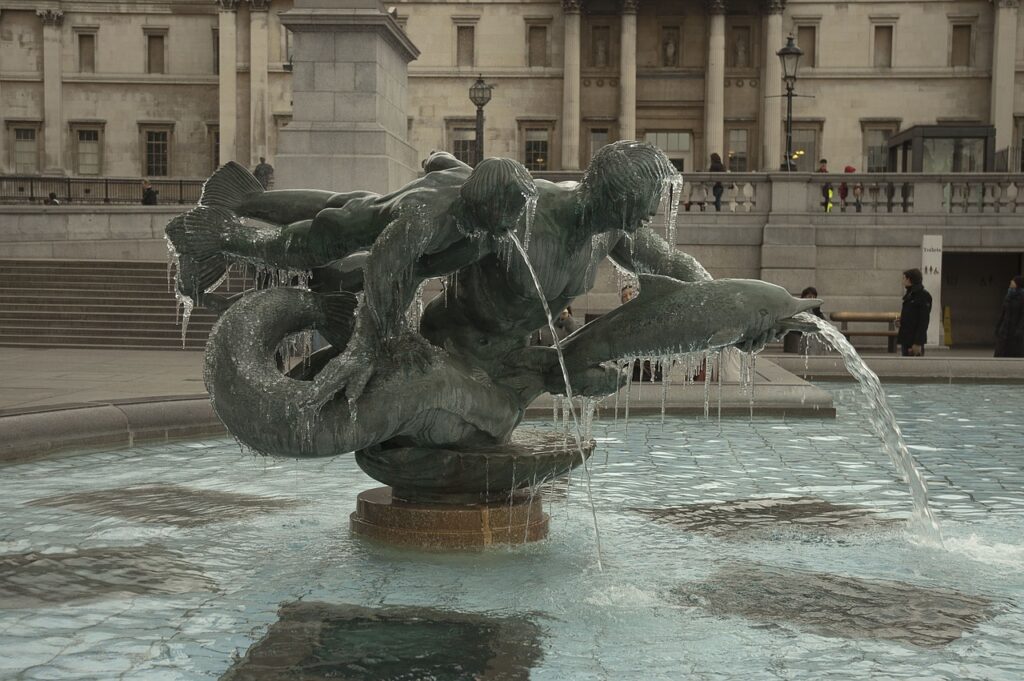
As I noted above, once you arrive at Trafalgar, a walk through the Admiralty Arch , down the Mall, past lovely St. James Park to the gates of Buckingham Palace, is about 7/10 of a mile. The palace has been in use by England’s royalty since 1837 and it’s immense–over 700 rooms. You’ll probably have a better view of the palace’s remarkable gates and the Queen Victoria Memorial if you arrive when the crowds aren’t there for the Changing of the Guard.

If visiting the UNESCO Heritage Site, the Tower and the Crown Jewels and returning to the Greenwich sites is a priority, we recommend walking back to Westminster Pier for a return trip back toward Greenwich. Your Thames Clipper River Rover or City Cruises ticket will take you to the Tower Pier and the New Armouries Cafe inside the Tower’s entrance, a good and inexpensive place for lunch. Check the Clipper’s timetable or the City Cruises timetable to make the best use of your time in Central London.
Or for those who would rather see other sites in London, here are a few of our favorites:
The British Museum
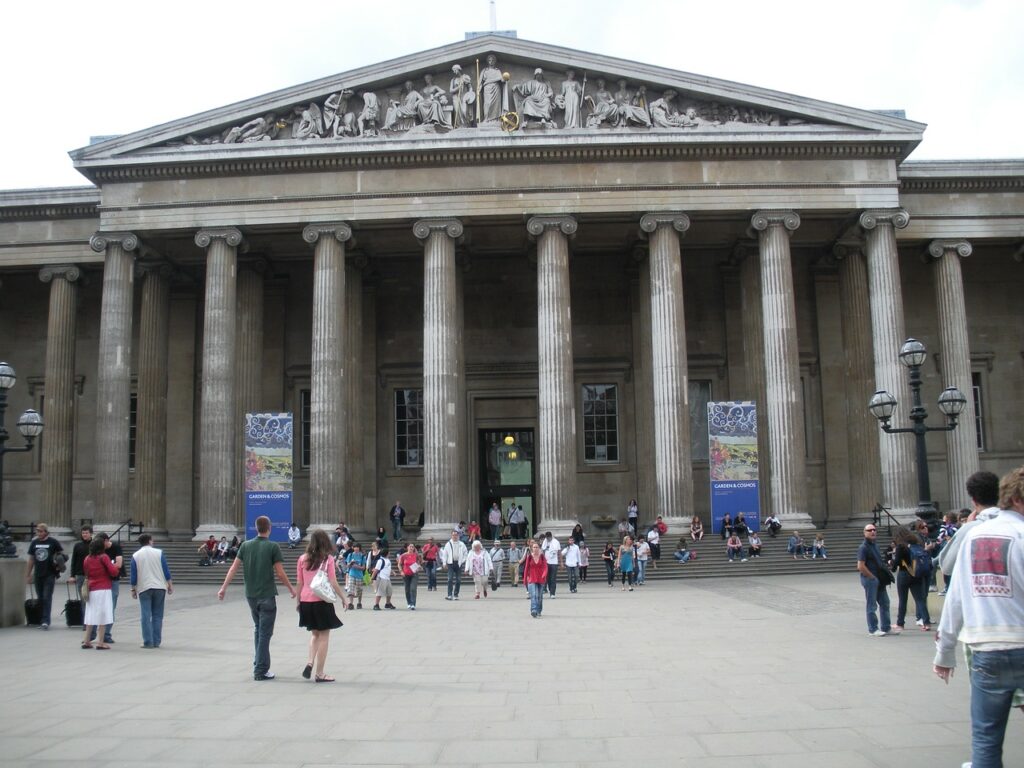
Gobsmacked is the best word to describe my impression of the British Museum. I spent many hours there as a college student in 1979 and each time John and I have visited since, we’ve always spend more hours than intended, wandering through its countless rooms and never seeing an end to all of the treasures it holds. Established in 1753, it’s the oldest public museum in the world, among the largest, and sets the standard for all others on the planet. It’s eight million artifacts, many gathered during Great Britain’s reign as an empire, date from the beginning of human culture to the present. Some of its priceless artifacts include the Rosetta Stone and the bust of Nefertiti, the Parthenon Marbles, the Koh-i-Noor diamond, the Sutton Hoo Helmet, and magnificent Native American artifacts that few museums in the United States can rival.
My most vivid memory of the museum is resting for two hours on a bench close to the Chinese collections while one of my students sketched and took copious notes of everything he saw. As a young boy, he immigrated to our community from China with his family and he was excited to share his discoveries at the museum with his parents and grandparents. Later in his journal entry I noticed his choice of the word “seized” when he discussed how Britain acquired these treasures. His perspective certainly placed the concept of imperialism in a new light for me, but this isn’t the place to wax political.
The museum covers 990,000 square feet and takes days to explore. Its two- acre Great Court is the largest covered public square in Europe, marked by a striking crisscross-patterned glass dome.
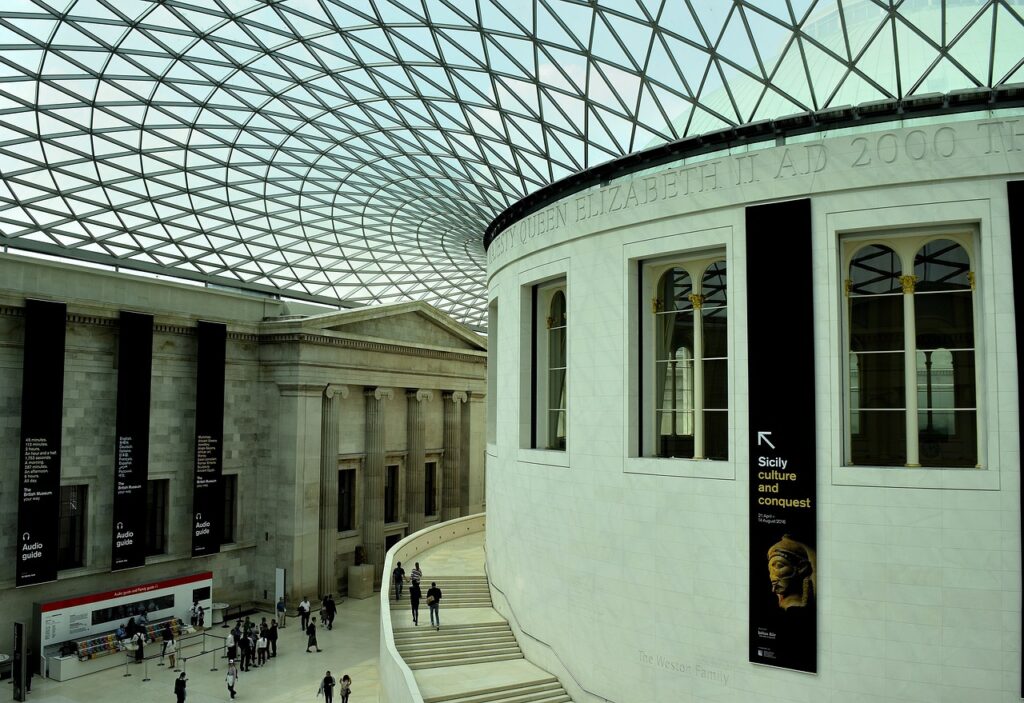
The museum’s entrance is free and includes a cafe and gift shop. It’s located a few subway stops from Trafalgar Square in Bloomsbury, an historic district of London. Depart Trafalgar Square’s Charing Cross tube station for the Piccadilly subway line, and exit at Holborn or Russell Square stops for a quick walk to Great Russell Street and the museum’s entrance.
Once a place to which literary figures and artists gravitated, Bloomsbury is now home to some of the world’s most prestigious colleges. You’ll enjoy the stroll through Bloomsbury’s garden squares where many old Georgian houses have been restored. If you had arrived in the city a century earlier or more, you may have crossed the paths of literary figures Virginia Wolf, Charles Dickens, and Mark Twain or the famous arts and crafts textiler, William Morris.
(One day really isn’t enough time to spend in London, but there’s so much more of Europe to see.)
The Imperial War Museum
A subway ride from Trafalgar’s Embankment to Elephant and Castle station and a two block walk on Lambeth Road, lies John’s favorite London destination (and one of mine)–the Imperial War Museum. Housed in a large building that was originally home to Bedlam–the Bethlehem Royal Hospital from 1850 to 1930, this fascinating museum is true to its mission: “See war through the eyes of the people who lived it. Be moved. Be inspired. Be transformed.”
The museum houses hundreds of artifacts documenting all angles of war from the advent of WWI in 1914 to the present. The museum’s contents will quickly captivate your attention from the tiny shoes of the youngest victims in the somber Holocaust exhibit to immense fighter planes suspended at different levels from the atrium ceiling.

The museum’s most significant contribution, however, is the great care curators take to ensure every exhibit communicates with artifacts and empathy, the human experience during wartime in bygone eras. The past with all of its struggle and sacrifice is carefully documented here as those who lived it, grow old and pass away. We knew nothing, for example, of Operation Pied Piper, the evacuation of approximately 1.5 million children from England’s largest cities beginning in September of 1939. These children were sent to the British countryside, Canada, Australia, and the United States to escape the inevitable wrath of German bombings. Many were not united with their families until 1945 when the war had ended.
The most intriguing exhibits include a simulated World War I Trench, a World War II bomb shelter with German aircraft screaming above, and a typical London family’s home at twilight, complete with Churchill’s speech on an authentic to the era radio. However, when I emailed the museum to recently to make sure these exhibits will be there when we arrive, I received a fast reply from a museum attendant. He explained that due to major refurbishment, much of the WWII section won’t be available until 2021.
Still, there are many exhibits to see in 2020. Once again, the museum is free and includes an inexpensive Cafe with terrace seating and views of the atrium and a gift shop.
Churchill’s War Rooms

If you’re a fan of the popular Netflix series The Crown and award-winning films including Dunkirk and Darkest Hour, one of London’s newer renovated historic sites is a logical stop. A significant history lies beneath the streets of Westminster in the Churchill War Rooms, and this museum brings to light some of England’s darkest days during World War II as it highlights the life and leadership of Prime Minister Winston Churchill. It was in this underground bunker that Churchill commanded operations leading to Germany’s eventual defeat. The structure was put into commission days before England declared war on Germany in 1939 and abandoned shortly after Japan’s surrender in 1945.
Although the public knew nothing of the annex’s existence during the war, audio-visual technology and interactive exhibits provide visitors today with an in-depth glimpse of the events that occurred here as Churchill and his War Cabinet weathered the storm of war including the London Blitz from 1940 -1941.
The entrance to the museum is located approximately one block west of Westminster Subway Station on Horse Guards Road and across from St. James Park Lake. Tickets are GBP 23 (about $30) and the museum includes The Cafe Churchill War Rooms and a gift shop.
The National Gallery
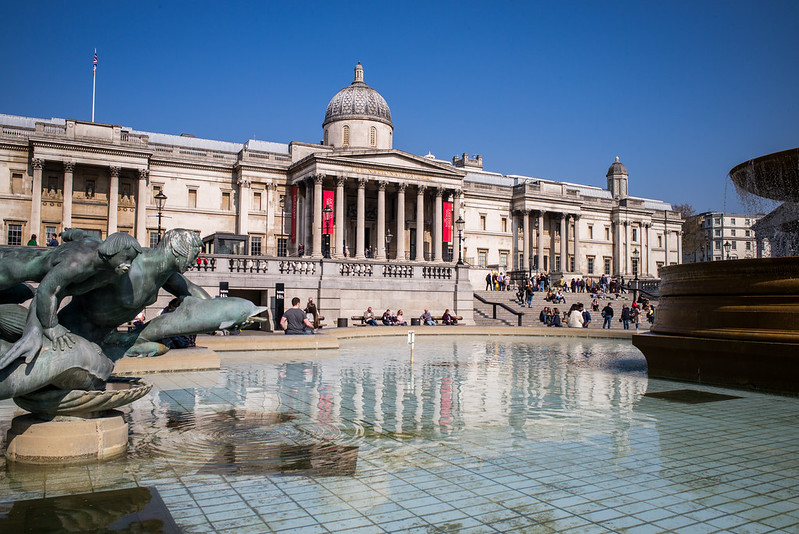
Even fellow travelers who have never had a desire to step into an art museum, are amazed at their experience in London’s National Gallery, a grand Neoclassical building which has faced Horatio Nelson’s column in Trafalgar Square for nearly two centuries. From Leonardo DaVinci to Michaelangelo, to Bruegel and Rubens, to Renoir, Monet, and Van Gogh, this museum’s collection of over 2000 works is considered the most comprehensive of European art treasures in the world.
And it’s free.
Like many of London’s museums, it’s impossible to explore all this gallery has to offer in one day. However, venturing past the museum’s immense portico and allowing an hour to glimpse some of the masterpieces you’ve only seen in textbooks is a surreal experience. Once you pass the main desk and enter the Central Hall, turn right for later artists’ work including Monet and Suerat. Or, venture left through the 16th century paintings to the Sainsbury Wing for Michaelangelo and DaVinci.

For two centuries, the National Gallery’s purpose has been to provide England’s citizens, “the socially excluded and the privileged; the uninformed and the expert” with access to some of the world’s finest art for education and enjoyment of the widest possible enjoyment.” A testament to the cultural value the British people place on the museum’s many works is evidenced in a story dating back to the advent of World War II when Hitler’s invading troops confiscated millions of dollars of art treasures in other European countries.
In 1939, days before England declared war on Germany, Churchill ordered the museum’s millions of pounds worth of paintings transported out of London to safer places across the British countryside—even in a slate quarry in northern Wales. When concern was voiced that the artwork would be safer in Canada, arrangements were made for the journey. However, museum director Kenneth Clark contacted Churchill, fearful the ships carrying the art would be bombed in the Atlantic. In a letter to Clark, Churchill responded, “Hide them in caves and cellars, but not one picture shall leave this island” (qtd. in Bosman).
The museum also houses a cafe and three gift shops featuring art-related gifts and London souvenirs.
Churches, Cathedrals, and Evensong
London’s Christian tradition dates back over 1500 years to the 7th century and each of its more than 50 cathedrals and churches contributes a unique history to that tradition.
Museums serve an important purpose. They allow us to examine the human experience third hand through their display of exhibits and artifacts. However, we encounter something far more significant wandering through old churches and cathedrals. In these centuries’ old structures we get a first-hand sense of the ebb and flow of human existence when we consider the hundreds and thousands of christenings, weddings, and funerals these places have witnessed.

At least, that’s the illumination I took away from my first visit to St. Paul’s Cathedral in 1979 when I gazed up at its intricately designed dome, soaring above me. In fact, among my best memories of that interim semester at college are the Evensong services at St. Paul’s Cathedral I attended many afternoons, and they’re still offered today every Monday through Saturday at 5:00 pm after the church closes to visitors.
Historians believe a church has stood on the site of the present-day cathedral since 604 when Anglo-Saxon King Ethelbert built a church in honor of St. Paul. Following a fire in 1087, a large gothic structure rivaling any in England replaced at least one previous structure. This building, subjected to ravages of time and political strife, fell into disrepair and was completely destroyed in the Great Fire of 1666.
The present St. Paul’s, like many of the 50 centuries-old churches and cathedrals damaged in the Great Fire, was designed by Christopher Wren. Inspired by Michelangelo’s dome in St. Peters Basilica, St. Paul’s dome rises 365 feet. It was the tallest structure in London through the 20th century and at Wren’s orchestration, loomed above all of the spires of all other churches that surrounded it.
St. Paul’s narrowly escaped the wrath of the German Luftwaffe on the night of December 29, 1940, when bombers returned to the city yet again with a vengeance dropping parachute bombs and explosive devices by the tens of thousands. When a powerful 2100 GMT landed on the cathedral’s roof, Churchill ordered the church be saved at all cost, concerned that the destruction of London’s most prominent landmark would take its toll on its citizens’ morale. Miraculously, it was saved through valiant efforts of firemen and volunteers on a night in which 162 Londoners lost their lives and the city suffered another round of devastating destruction (“How St. Paul’s Survived the Blitz”).
Evensong services at St. Paul are free and begin after visiting hours at 5:00 pm. Prior to that, visitors to the church outside of its other services are required to pay an entrance fee of 20 pounds (about $26). A cafe and gift shop are also available.
Many other churches have historical significance:

Westminster Abbey, founded by Benedictine monks in 960 A.D, has been England’s coronation church since 1066. Recognized as a UNESCO World Heritage Site, this majestic gothic-style cathedral is the burial place of 17 monarchs and home to Poet’s Corner, a burial and memorial site for over 100 of England’s literary figures. The church lies South of Westminster Pier and charges an entrance fee during visiting hours. Services and Evensong are free.
St. Martin’s in the Field, established as early as 1222, faces Trafalgar Square across the street from the National Gallery. It’s noted for its noontime and evening concerts and its Cafe in the Crypt.
Wesley’s Chapel was completed in 1778 under the direction of John Wesley, the founder of Methodism. Admission to the church and Wesley’s home is free Mondays through Saturdays from 10:00 am to 4:00 pm with last admission to the house at 3:15 pm. Donations are appreciated. It can be accessed via the nearest underground station, Old Street.
Concealed between Fleet Street and the River Thames, Temple Church dates back 800 years. It was built by the Knight’s Templar and consecrated in 1183. The preliminary charters of the Magna Carta were created here as the church served as King John’s London headquarters in 1215.
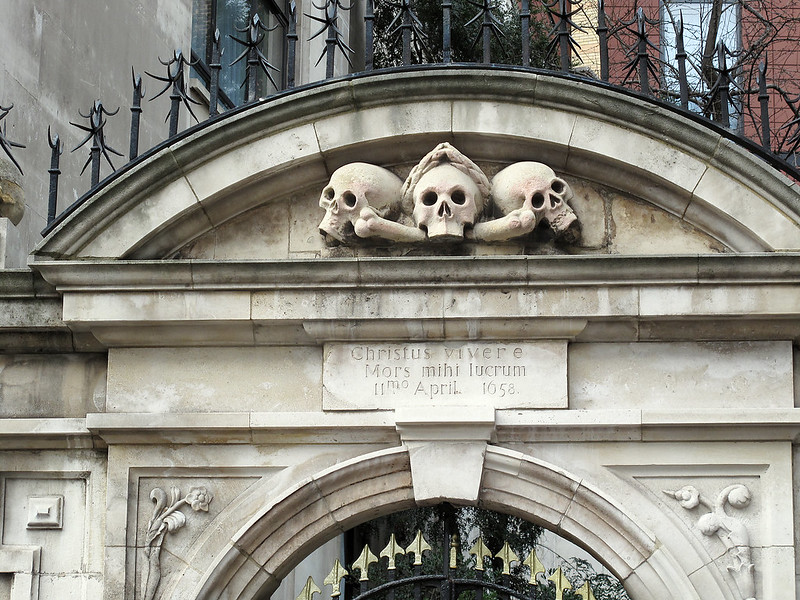
Lesser known St. Olave’s is one of the few remaining medieval structures in London. Charles Dickens referred to it as “ghastly grim” for the skull and crossbones above its front entrance. It’s believed to be built on the site of the Battle of London Bridge where King Olaf II of Norway fought gallantly alongside King Ethelbert against the Danes. The current building, which dates to 1450, escaped the Great Fire of 1666, but seriously damaged during the London Blitz. It’s restoration was completed in 1954 and for the past 50 years is home to free concerts featuring classical music each weekday at 1:00 pm. Donations are appreciated. The church, which can accessed from Tower underground station, is usually open to visitors Monday through Thursday from 10:00 am to 5:00, but please contact the church office in advance.
Topping off the Day with a Good Meal
There are many choices on Greenwich’s High Street on which our hotel is located. If conserving travel dollars is a priority for this trip, the variety of restaurants in Greenwich will provide good, hearty fare for significantly less than those in the heart of London. For example, the Cafe Rouge is a block from our hotel and I recall it offered a savory ratatouille–the best I’ve ever eaten, and a great mushroom risotto.
And, the Mitre Pub that accompanies our hotel, offers a broad range of entrees, global as well as British, with many rave reviews.
Day Three, Journey to Dover
We’ve hired a minibus from Britannia Coaches of Dover, England, to pick us up at our Greenwich Hotel at 9:00 am and transport us for an hour’s journey through Kent to Dover, situated on the shore of the English Channel. It’s our last stop in the United Kingdom before crossing the English Channel and moving on to the European continent on Day 4 via P.O Ferries.
DIY Tip #4: If Time Allows, Stop at Leeds Castle
On three other trips, we’ve stopped at Leed’s Castle nestled in the Kent countryside near Maidstone and conveniently located halfway between London and Dover. Dating back to its acquisition by Eleanor of Castile in the 13th century, the castle’s rich history is closely tied to the many generations of royal owners including Henry VIII who renovated it as a love nest for his first wife Catherine of Aragon. Considered today “the loveliest castle in the world,” the museum charges an entrance fee of 27 GBP (about $35) and includes a scenic walk to the castle itself, situated on an island in a lake formed by the river Len. The grounds also feature a cafeteria style restaurant with exceptional food and a maze that ends in a grotto.
Dover Castle, A Thousand Years of History
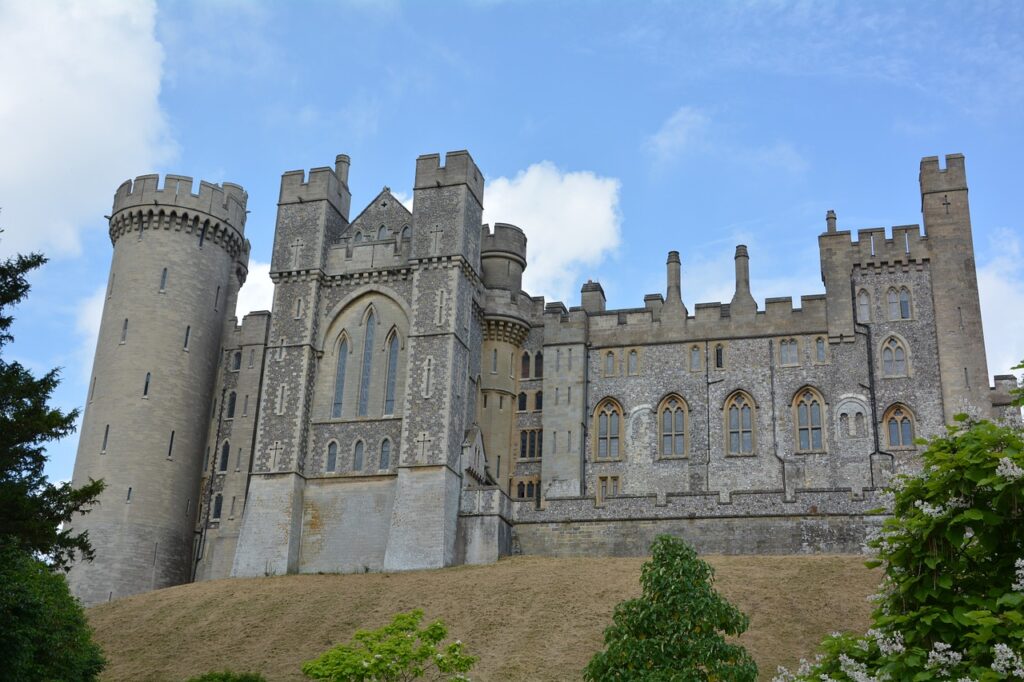
Instead, at the recommendation of friends, we’ll visit the equally touted Dover Castle on this trip, arriving between 10:30 and 11:00 am for a three-hour visit. This 1000-year-old castle is a national treasure. As a fort, it has defended England faithfully for 900 years, even up through WWII. It features new interactive exhibits highlighting the castle’s significant role in WWI and WWII including Operation Dynamo in 1940–the rescue of 335,000 British troops from Dunkirk, France, as the Nazis approached.
If you haven’t seen the award-winning film Dunkirk (2017), take a couple of hours in the months before departure to view this inspiring movie for a more enhanced perspective of Dover’s role in the war efforts.
Although we will visit Dunkirk, France, on Day 4, travel forums report the best museum commemorating the event is here at Dover Castle. The Dunkirk invasion was planned within this structure and features a labyrinth of secret underground tunnels that also contributed to the operation’s success.
And, sometime during your visit at the castle, be sure to grab some lunch at one of the four Castle eateries. The castle has a GBP 20 entrance fee (about $26) and limited hours—weekends only November through February and Thursdays through Sundays the remainder of the year.
We’ll meet our Britannia Coach again at 2:00 pm to check into our rooms at the Premier Inn Dover Central. We’ve stayed at this particular hotel before and had a happy experience. In fact, we’ve stayed at several Premier Inns in England and Scotland. The hotel chain has over 800 hotels across England, Scotland, Wales and Ireland. While these hotels lack the quirky English charm of generations old hotels or bed and breakfasts, customers can rely on modest, but clean and comfortable rooms and a hot breakfast for usually under $100 a night. Lunch and evening meals are also available at each hotel’s onsite restaurant.
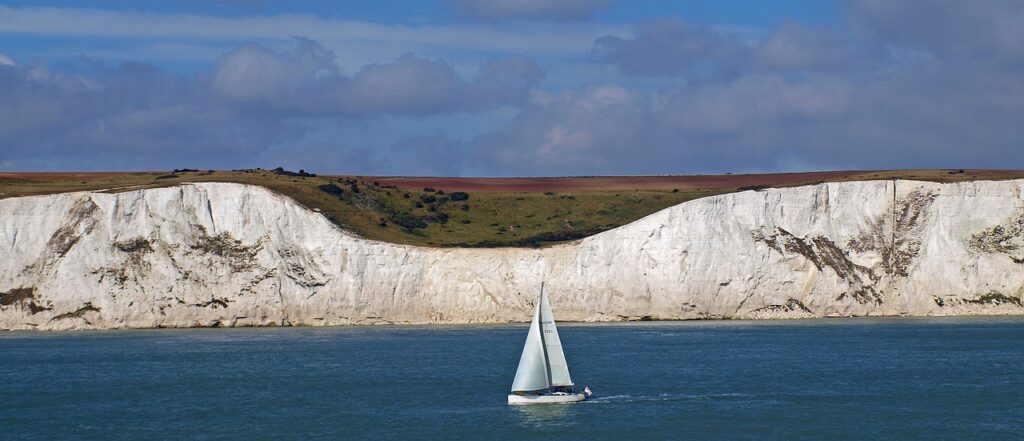
An Afternoon and Evening in Dover, England
The little city of Dover lies at the narrowest point of the English Channel between England and France and has undoubtedly served as the gateway to the country since the days of ancient Rome and before. Noted for its iconic white cliffs towering over the bay, the town is situated at the threshold of the busiest shipping lane in the world. The Dover area boasts many attractions with historical and cultural significance and one afternoon is far too short of a time to spend here.
However, in the afternoon hours remaining there’s time for a sea-view walk along the promenade and maybe a stop at De Bredelei Wharf, a quirky outlet mall a short distance from the hotel.

Or, there is a path right behind our hotel, uphill and past the castle, for an overview from the Cliffs of Dover. It’s part of the England Coastal Path which includes the South Foreland Lighthouse on its route (about a 3 mile hike from our hotel or five miles by vehicle). As an added incentive for the walk, consider stopping at Miss Knott’s Tearoom, reminiscent of the 1950s, complete with vintage tea cups and nostalgic music in the background including Vera Lynn’s “The White Cliffs of Dover.”
Ending the Day with an Evening Meal
We can make plans for dinner together at one of many Dover restaurants including our Hotel’s Table Table or venture out on your own. And later in the evening Dover has many pubs to watch a game or test the local lager. A favorite of visitors and locals alike is the White Horse, established in 1574 and the oldest public house in Dover. Only a five minute walk from our hotel, it’s also an excellent option for an inexpensive evening meal.
Tomorrow we say goodbye to the United Kingdom.
DIY TIP #5: Options for Transportation from Calais, France, through Europe: Train, Rental Car, or Chartered Minibus
By Train: If your group consists of 2 – 4, train travel is good option if you only plan on visiting major cities. You can book a “foot passenger” ticket on P.O. Ferries from Dover and upon arrival in Calais, walk the 1.5 miles or take a taxi to the Calais train station for tickets to destinations across the continent. (Note: Some websites mention a shuttle, but it is no longer in operation.) If you carefully research schedules and fare information for trains, buses, and taxis, you can have a pleasant and relatively stress-free trip.
By Rental Car: Because most countries on the continent of Europe drive on the same side of the road as we do in the United States, traveling by rental car is a viable option if you are accustomed to big city driving. Make sure you have authorization to drive your rental car through all of the countries you wish to visit and study the driving regulations for each country. Customizing your own trip is a perk, but have plenty of pocket change for toll roads and vignettes, allow ample time to get lost, and be prepared for parking frustrations.
By Chartered Van or Minibus: If you want to be worry-free of tolls, taxes, and parking fees, and arrive at each destination relatively on time, chartering a van or minibus with a driver is your best option for groups larger than 4. Although traveling by this mode allows you the freedom to customize your trip as you please, you must have the company approve a day to day plan from which there is little deviation–European drivers, like those in the United States, are regulated by operation and rest hours each day.
Although we have had excellent chartered service from U.K’s Scotland and Bates on several trips, we have booked a mini-bus and driver for our upcoming trip through City Tours Gmbh, an affiliate of a service we used in Venice, Italy in 2015. When divided among multiple travelers, the difference in cost is often little more than relying on trains and taxis or a rental car. Make sure you request that all tolls, taxes and parking are included in the contract. In turn, you will be asked to arrange and pay for the drivers accommodations.
Day Four: On to Bruges via Dunkirk, France
After breakfast at the Premier Inn, we’ll meet our Britannia coach driver once again at 9:00 am and make the very short journey to the ferry terminal for our 90 minute passage across the English channel to Calais, France. Our driver will remain with us until the later afternoon when he drops us off at our hotel in Bruges.

This process requires us to get off the bus once we are on the ferry and move up to the large passenger decks. The decks include many comfortable seats on multiple levels from which you can view the sea, a gift shop with many duty-free items and souvenirs, and a cafeteria. Here’s your last chance to get your scones and clotted cream if you missed them in England.
Turn your watches ahead one hour when we return to the parking level of the ferry and board our minibus to disembark in Calais, France, with a noon arrival time.
DIY Tip #6: Always Carry Your Passport.
Disregard the travel sources that recommend you lock your passport in a hotel safe when you’re staying at one destination for several days. Out of site and out of mind, it’s too easily forgotten.
Likewise, never pack your passport in a carry-on or suitcase from which you can easily be separated.
Carry your passport on your person at all times–it’s safest in a waist wallet under your clothes. You’ll be asked to present your passport on multiple occasions including at the customs port in Calais. In fact, you will not be allowed into France without it.
Dunkirk, France and UNESCO’s St. Eloi Belfry
Once we are through customs, we’ll have a 45-minute drive through the French Flanders region to the coastal town of Dunkirk for a two-hour lunch break and free time near UNESCO’s Beffroi de St. Eloi. Dunkirk is France’s northernmost city and an old fishing village dating back to the 10th century. In fact, in old Flemish, the name literally means church or kerke in the dun or Dunes.
Saint Eloi’s current facade was completed in 1889 to replace earlier structures of the 15th century church, ravaged by time and war. For a brief time during the French Revolution, Catholicism was banned and St. Eloi along with many other French churches became a Temple of Reason–an alternative system of belief based on reason and atheism and designed to replace Christianity. The church also played a significant role in the development of the metric system devised in the 18th century.
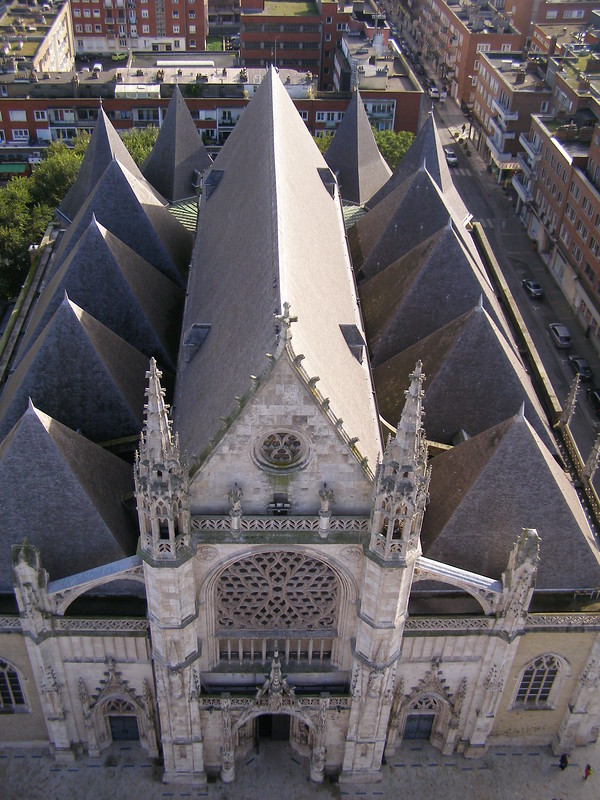
Partially destroyed in both World Wars and rebuilt, bullet holes are still visible in the church’s front wall. St. Eloi’s grand facade is marked with a large round rose window, characteristic of other gothic-style churches including Notre Dame in Paris.
The Belfry, all that remains of the original church burned by French troops in the 17th century, stands across the street from St. Eloi. The bottom half serves as a tourist information center and for a fee of 3 Euros (app. $3.30), visitors are allowed to climb the tower for a panoramic view of the city, Dunkirk’s harbor, and the ocean beyond.
Of course, this city is famous in more recent history for the Dunkirk Miracle of 1940, the evacuation of thousands of British Troops from its beaches approximately one mile from the cathedral.
Immerse Yourself in an Authentic French Experience
In many European countries and especially France, most business ceases from noon until 2 pm for shopkeepers and workers to enjoy a leisurely lunch and a rest. Because we will probably arrive in Dunkirk during this “sieste,” some places may be closed. However, there are many restaurants and cafes in front of the church along Galo and Place Jean Bart streets. Afterward, when the church and the Belfry reopen, you can explore the interior of the church or climb to the top of the Belfry. Or, you can briefly immerse yourself in the French experience in the shops surrounding the church.
Sadly, because there are so many other places to see, our time in France will be brief. However, our stop in Dunkirk is an opportunity to experience the unique French culture from an authentic perspective because the city doesn’t attract large tourist crowds. In fact, Dunkirk is even noted by FluentU journalist Kristen Ambrose as one of nine small French towns to visit for a genuine glimpse of the culture.
We’ll leave later in the afternoon for a 45 minute ride to our hotel in Bruges where we part ways with our Britannia bus driver. Our City Tours driver for the remainder of the trip will join us on Saturday evening. Our home base for the next two nights is the Novotel Centrum Hotel in the heart of the old City Center of Bruges, Belgium.
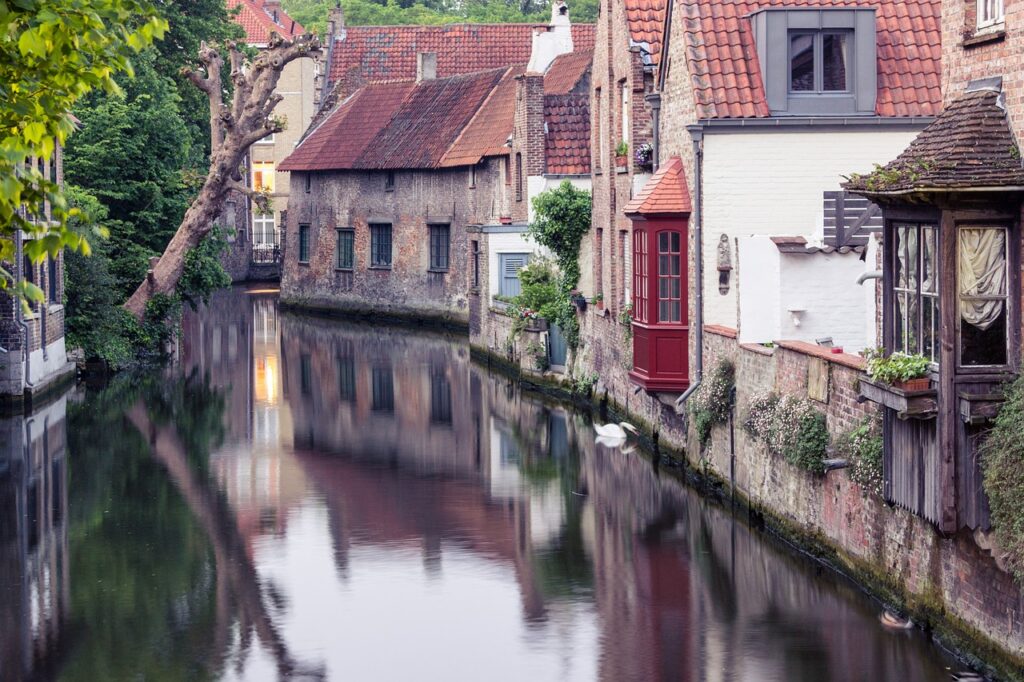
We have had only good experiences with this hotel the three times we’ve been guests in the past. Novotel is a midscale hotel brand focusing on comfort and part of the AccorHotel chain. In fact, join the Accor loyalty program for a discount at this hotel and others included in the chain.
DIY Tip #7: Become a European Hotel Chain Groupie
We recently discovered the perks of hotel brand loyalty at home in the United States–discounts, room upgrades, etc. Consider joining the loyalty programs of the popular hotels abroad including Premier Inn and those in the Accor chain which include Novotel, Ibis, and Mercure. To ensure you are eligible for perks and to avoid confusion with reservations, always book directly with the hotel brand. Download their apps for even more convenience.
Supper?
We’ve eaten evening meals at the Hotel restaurant several times where the Belgian specialty, Carbonade Flamande is served. It’s a savory beef stew and so good. However, there are also pubs and restaurants surrounding the hotel within a block or two. You will not go hungry in Bruges.
Day Five: Bruges!
I’m not sure where to begin. Bruges is our favorite destination of all the places we’ve traveled. This video in 4K doesn’t do the city justice. Furthermore, maybe because the city has remained unscathed through the bombing of the World Wars, Bruges is recognized as UNESCO World Heritage Site for its authentic medieval character reflected in its architecture and canal ways. Get up early and don’t miss a minute of your free day in this city.

After a hearty hotel breakfast, plan on a full day in one of Europe’s loveliest cities. Occupied by the Nazis during WWII, Bruges is one of the few cities that escaped destruction. Often called the Venice of the North because of the many canals that run through the heart of the old town, much of its medieval architecture has remained intact. There are too many historical attractions to mention including The Basilica of the Holy Blood which exhibits a vial said to contain a fragment of cloth used to wipe the brow of Christ.
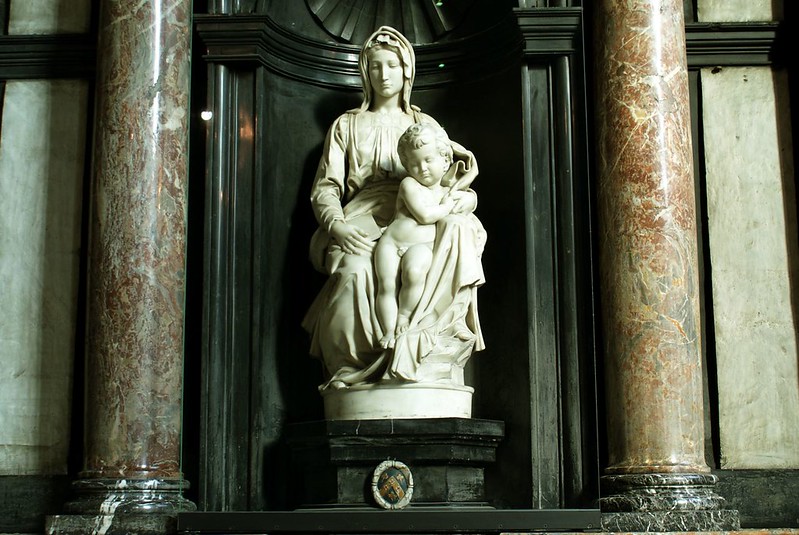
Entrance to the basilica and almost all other attractions worth seeing are free. However, one remarkable antiquity you might want to pay a small fee to visit is found in the museum section of the Church of Our Lady, on the way to Market Square a few blocks from our hotel. It’s the Madonna of Bruges, the 16th century work of Michaelangelo, and his only work to leave Italy in his lifetime. It was brought to Bruges by wealthy cloth merchants in 1504 and removed twice–once by the conquering French in 1794 but returned after Napoleon’s defeat at Waterloo in 1844. It was stolen again by retreating Germans who smuggled it out of the city in a mattress in a red cross truck. It was located after the war in an Austrian salt mine.
This story and the effort to rescue millions of dollars of other priceless European art is the subject of The Monuments Men (2013), starring George Cloony, Cate Blanchett, and Matt Damon.

And, our timing is perfect for the Saturday flea market along a canal of the Divjer River, also on the way to Market Square. If you are a shopper, Bruges is your place for lovely gifts from the finest chocolate, lace, scarves, clothing, wooden toys, Christmas ornaments, jewelry, embroidered everything, antiques, and much more. (Our prized travel souvenir is an antique brass candelabra with porcelain hand-painted parakeets and blossoms we found for $15 at a small second-hand shop near the Basilica of the Holy Blood.)
The Belfry of Bruges
Our favorite spot for coffee and Belgian sweets? An outdoor cafe on the corner of Market Square in close view of horse drawn carriages and the Belfry of Belgium immortalized in Longfellow’s 1845 poem. Dating back to the 12th century, the belfry bells have regulated the lives of Brugians for centuries. The tower looms 270 feet over the town square and is the key component recognizing the area as a UNESCO Heritage Site. For a small fee, visitors can climb the 366 stairs to the top for a panoramic view of the city.
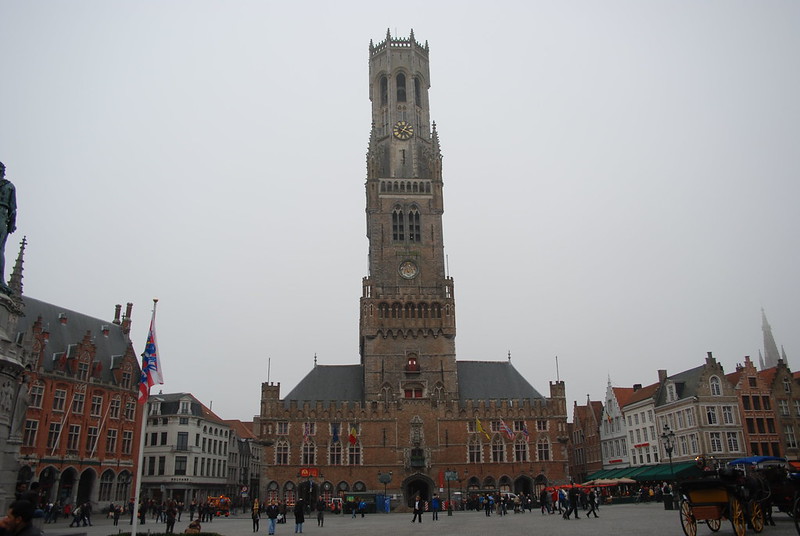
Eating your way through Bruges?
Unfortunately for our waistlines, Belgian food is phenomenal and you will be overwhelmed with the choices. One blogger has provided some insight to help you make some tough decisions: Fairytale Dining in Bruges: 8 Magically Delicious Places on a Budget.
In the later afternoon, John has persuaded me to return with him to the De Halve Maan Brewery close to our hotel. Our last time there we learned so much about the history and gained a new appreciation for the tradition behind Belgian Beer. The tour is 12 Euros a person with a reservation in advance. The last tour on a Saturday is at 5 pm.
Day Six, The Cologne Cathedral and Boppard, Germany
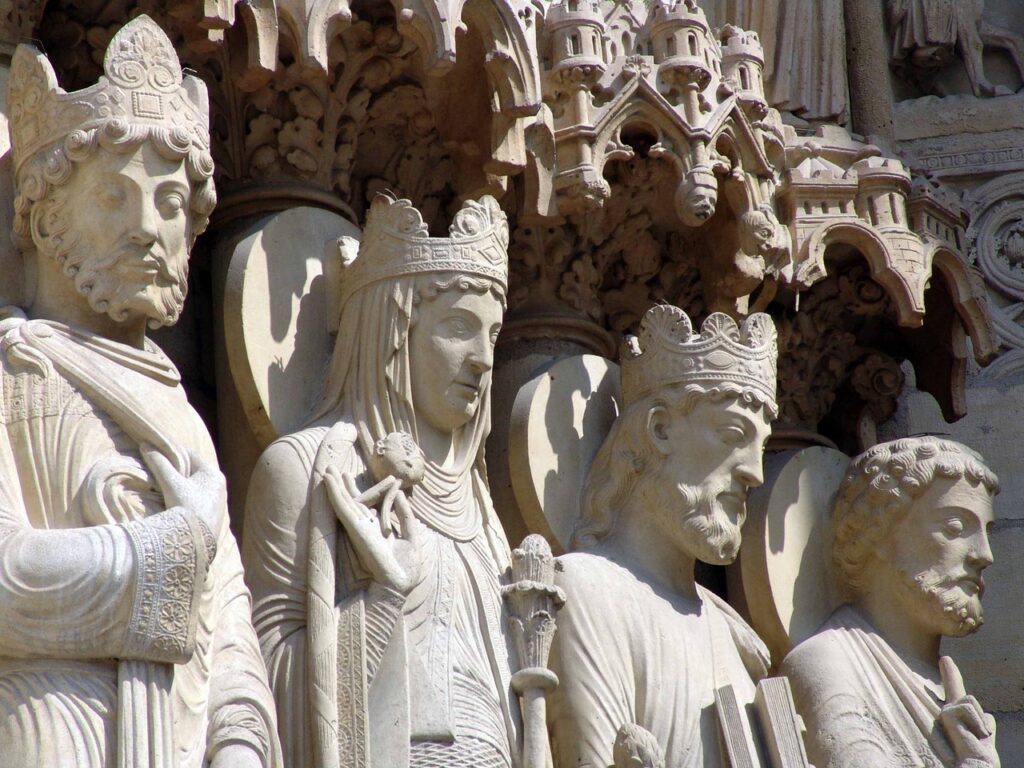
I’m always sad to leave Bruges behind. I know our lives’ days are numbered and wonder if we will ever be able to return to this magical city. However, our visit to the Kolner Dom (Cologne Cathedral) in Cologne will be just as intriguing.
We’ll leave our hotel in Bruges at 9 am for our three-hour road trip to Cologne with a rest stop at the Netherlands American Cemetery in our brief sojourn through the Netherlands. Located near the small village of Margraten, this cemetery marks the final resting place of 8291 American soldiers who lost their lives as the United States pushed into this area from France during World War II. The site includes a visitors center, a chapel tower, and a small museum. A reflecting pool marks the Court of Honor and on either side Tablets of the Missing include the names of 1722 soldiers missing in action.

The Netherlands suffered significantly under the Nazis and even eighty years later, the graves are carefully tended by surrogate Dutch families, a practice started in 1946.
We will arrive in Koln (Cologne, Germany) a little before 1:00 pm for lunch and visit to the cathedral.

Pictures can’t capture this church’s magnificent details, so don’t even try. Hands down, it’s the most beautiful man made structure we have seen. Declared a UNESCO World Heritage Site in 1996, construction of this massive cathedral began in the 14th century but was halted in 1473. Work began again in 1840 and the cathedral was completed in 1880. It was the tallest man-made structure until the completion of the Washington Monument years later. Today, the cathedral boasts the world’s largest church facade and tallest gothic spires and the third tallest spires overall.
The church itself is free with a 3-Euro fee to climb the tower or 5 euro to enter the church treasury which contains items used through the centuries–chalices, liturgical vestments, manuscripts and more. However, on the high alter, free for all to see, is the Shrine of the Three Kings, the world’s largest medieval reliquary, exquisitely adorned with carvings of apostles, angels and other religious figures. For centuries, the legendary shrine was said to contain the bones of the three maji wrapped in white silk. However, when it was opened in 1864, the bones of Phillip I, one of the first archbishops of Canterbury, were found instead.
About two blocks or an 8-minute walk from the cathedral is the NS Documentation Memorial, a building that housed the Gestapo Headquarters during Nazi Germany. We have not visited this museum, but students did on previous trips and found it worth their time for those interested in the history of the Third Reich.

And in Cologne, Boppard, Heidelberg, and Rothenburg, look for the stumbling stones or Stolpersteine, commemorative gold cobblestones in front of the last voluntary homes of Jewish citizens. These stones which are banned in Munich, are engraved with the names of holocaust victims and the details of how and where they perished–somber memorials of Europe’s dark days not so long ago.
We’ll leave Cologne at 4:00 pm for an hour or more drive to our evening destination, the Hotel Eberter in Boppard, Germany. Although we have never stayed at this hotel, my multiple email with Iris, one of its receptionists, have been nothing but prompt and professional and we are looking forward to our stay.

The hotel features its own restaurant, and there are a number of pubs and restaurants surrounding the hotel. Nestled in the heart of the Upper Rhine Valley UNESCO World Heritage site, Boppard is noted in particular for its position on the largest loop of the Rhine River and its centuries old tradition of wine-making.
After dinner, there still may be sunlight to see the remains of a castrum, an ancient Roman fort dating to 380 A.D., one to two blocks from the hotel.

Day Seven, The Rhine River Valley and Colmberg Castle
After our hotel breakfast, our coach leaves promptly at 8:30 to take us a short distance to our Rhine River departure from the Boppard Pier on the Koln-Dusseldorfer cruise company. The next two and one half hours we’ll meander down the River Rhine past castles, vineyards, and acres upon acres of rapeseed (canola in the United States) flowers–fields of gold–in full bloom in May.
Our river cruise includes the one hour passage of the Rhine that travel expert, Rick Steves considers the most interesting, the crook between Bacharach and St. Goar.

Our cruise ends in Bacharach, Germany at approximately 11:30 where our City Tours Mercedez and driver will be waiting for us.
In the afternoon ahead, we’ll stop in two of the most beautiful villages in Germany–a rest stop in Heidelberg and our evening meal in Rothenburg with a 30 minute drive to Colmberg Castle, our evening stop, at the end of the day.
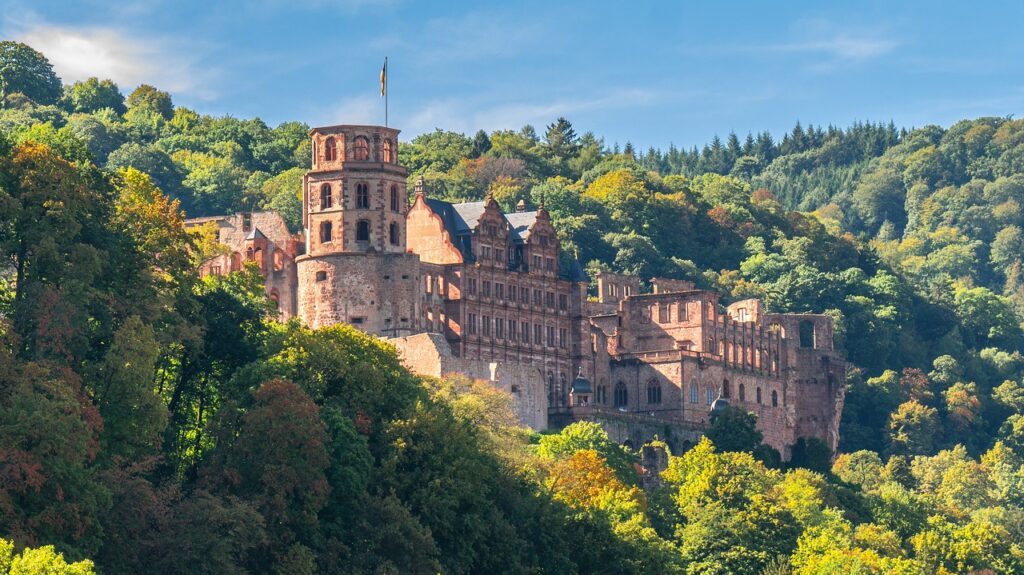
We’ll arrive in Heidelberg, Germany, around 1:30, but regretfully, must limit our visit in this historic city. Heidelberg is home to Germany’s oldest University, founded in 1386 and it has been designated a City of Literature by UNESCO’s Creative Cities Network.

With a 3:00 pm departure from Heidelberg, we’ll arrive in another picturesque medieval town of Rothenburg about 4:30. Rick Steves reports that Rothenburg is Germany’s best preserved medieval walled town, and because Germany has several Rothenburgs, many people arrive at the wrong city. The medieval Rothenburg that Steves recommends is often referred to Rothenburg Ob der Tauber for its location on the Tauber River. During the Middle Ages, Rothenburg was Germany’s second largest city with a population of 6000. Today it’s noted as the best shopping site in Germany. Fortunately, we are arriving on a Monday, when many Rothenburg shops may still be open until 8 pm.
Because the folks at Colmberg Castle told us with regrets that their restaurant is closed on Sunday and Monday evening, Rothenburg offers several good options including Zur Holle, a renowned restaurant featuring Rustikales Abensessen, authentic German specialties. The restaurant has been in existence since the 9th century and promises authentic medieval atmosphere.

The one thousand-year-old Colmberg Castle, our evening destination in the Bavarian Alps, is just 30 minutes away, and we’ll need to conclude our supper between 6:30 and 7:00 to enjoy the ambiance of the castle. “Around every turn you’ll find thick dark beams, low arches, imposing staircases, iron candelabras, fires crackling in stone fireplaces that face giant leather chairs, and stuffed stags, brown bears, ermine, boars, and hawks,” writes journalist Reid Bramblett.
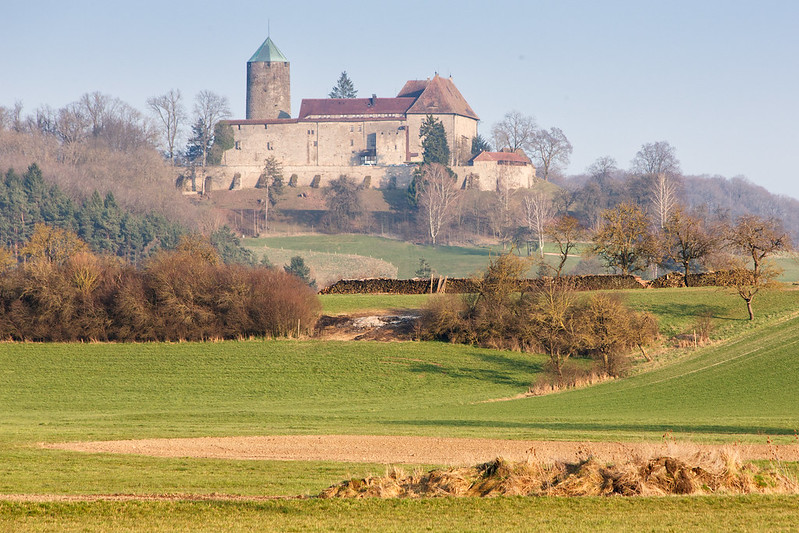
For five hundred years, this castle belonged to the Hohenzollern family which eventually produced the rulers of Prussia. Legend has it that Charlemagne was a guest and a hunter on its grounds. The Unbehauen family purchased the hotel in 1964 and have transformed it into the highly rated hotel it is today.
We stayed at Colmberg Castle in 2016 and consider it one of the most pleasantly unique experiences we have had at any hotel. We were intrigued by the authentic decor and brought away happy memories of our evening meal, friendly staff, a comfortable night’s sleep, an after dinner chat with our friends by the fire along with some eerie taxidermy.
At our recommendation, our friends spent a night here a few weeks ago, and reported their night at Colmberg Castle was a highlight of their trip.
Day Eight, Munich and Salzburg
Today we depart for Munich and after much deliberation, we hope you’ll benefit more from a 10:00 am departure from the castle rather than leaving at 8:00 am in order to stand in the Munich Marienplatz and watch the figurines in the Glockenspiel do their little dance.
We’ve been through Munich several times and saw the Glockenspiel movement just once–enough to agree with several travel critics that it’s one of the most overrated tourist attractions. Traveller magazine states, “This actually goes for any historic clock in Europe that tourists are encouraged to gather around to watch chime. These contraptions are glorified cuckoo clocks that ding and whir and spin underwhelmingly for a few minutes before everything stops and the assembled audience gradually drifts away wondering if they’ve seen the right thing or not.”
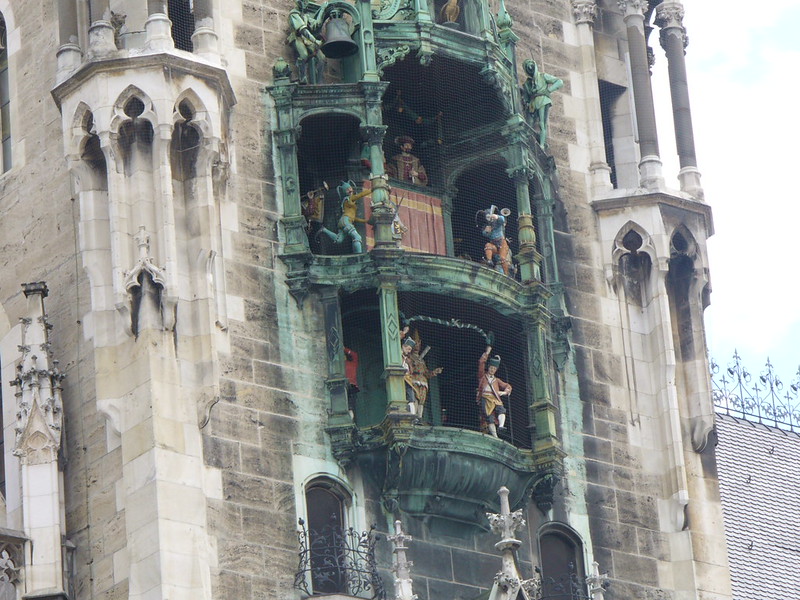
Of course, you will still see the Clock Tower with visible figurines and hear it chime its beautiful bells on the hour. The town hall which houses the clock tower and the Glockenspiel was completed in 1908 in Gingerbread Gothic Revival architecture. By good fortune, the clock tower remained unscathed although much of Munich endured heavy bombardment and significant destruction from allied forces.
Leaving at 10:00 am with the 2 ½ hour drive plus a rest break will put us in Munich at approximately 1:00 pm for our lunch stop.
We’ll have three hours for a leisurely meal and an opportunity to roam the streets of this famous city, the capital of Bavaria. Hands down, our favorite restaurant is Munich’s Hofbrau House open 365 days a year at 9:00 am. This restaurant is a centuries old beer garden noted for its food as well as its brewery.
We’ll leave Munich at 4:00 pm for the Hotel Elefant in Salzburg, Austria, our final destination of the day. The drive is approximately two hours through the alpine foothills with an arrival time in Salzburg at approximately 6:00 pm.
We have no experience with the Hotel Elefant. I chose it because of its excellent central location, the prompt and professional emails I received from its staff, and the great reviews from happy guests on several objective websites.
Our evening meal? We can’t get any closer to Old Town than the Hotel Elefant. In fact, the hotel is within one block of Amadeus Mozart’s birthplace, a popular Salzburg attraction. There are a number of pubs and restaurants close by including the restaurant in our hotel and Sternbrau with a reasonably priced menu within a block of our hotel.
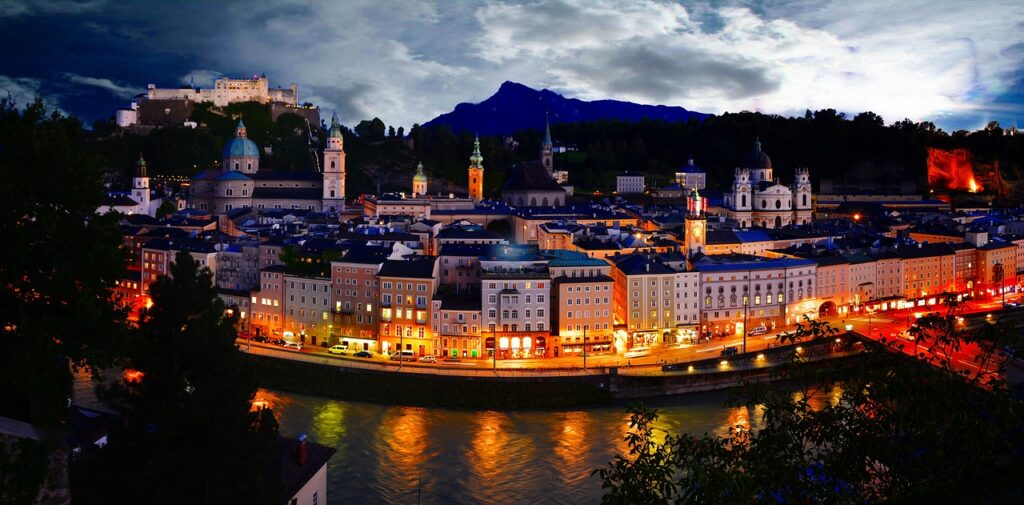
Day 9, Our Day in Salzburg
Salzburg, the fourth largest city in Austria, is a story-book town retaining much of the same charm it had when its most famous resident, Amadeus Mozart, lived here nearly 250 years ago. Our Hotel Elefant is conveniently located in Alstadt or Old Town and the entire area is recognized as a UNESCO World Heritage site. It’s attractions–museums, castles, cathedrals, concert halls, and markets are all within close walking distance of the hotel.
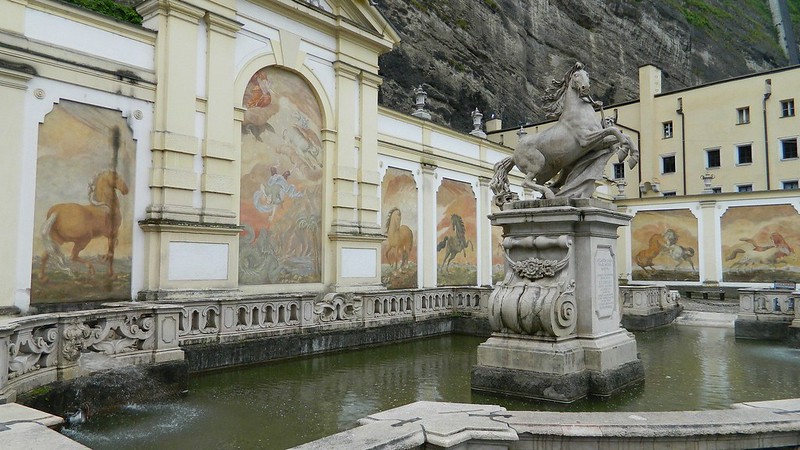
Because we have arrived at Day Nine and many of you may be “castled” and “cathedraled” out, this day is yours to roam Old Town as you please and admire its baroque architectures and many curiosities like the pferdeschwemme or horse bath, a four-minute walk from our hotel. As its name states, this pool and fountain dating back to 1602, was used to bathe horses.
For a change of pace, you may be in the mood to wander through the many shops including those in Getreidgass Lane, a medieval shopping mall in the heart of Salzburg. And, approximately a block from the hotel is the Grunmarkt, an open air market with all kinds of pastries, bread, fruit, cheese and other Austrian delicacies.
Step into the settings of The Sound of Music
If you are a The Sound of Music fan, you may wander through some areas of Salzburg that look familiar. A four-minute walk from our hotel is the Residenzplatz, a grand square in Old Town, laid out in 1587 on top of the cathedral’s medieval cemetery at the request of the Archbishop. It’s at this setting that Maria sings “I Have Confidence” and dips her fingers into the the Residenzbrunnen, a baroque fountain erected about 1660 and topped with a statue of the Greek god, Triton. It’s the largest baroque fountain in central Europe.

A short distance from Residenzplatz is St. Peter’s Abbey and its Catacombs. Although some tour guides claim this Benedictine monastery’s cemetery was used in the final scenes of the movie, this site merely inspired the recreation of the set in Hollywood. Established by St. Rupert in 696, St. Peter’s is the oldest monastery in the German-speaking world and its cemetery and catacombs are the believed to be the oldest burial place in Europe. Today, the only remnant of the original church is the ground floor of the West Tower. The current structure, built in 1130 when the church was ravaged by fire in 1127, is an exceptional example of Romanesque architecture. The church also houses the oldest library in Austria with 100,000 volumes, some dating back to the 8th century. St. Peter’s cemetery is one of the most visited sites in Salzburg with intriguing gravestones dating back to the 13th century and catacombs carved into the cliff overlooking the church. Entrance to the church is free with a 2 euro charge for the cemetery and catacombs. May through September its visiting hours daily are 10:00 am to 12:30 and 1:00 to 6:00 pm. The remainder of the year the church closes at 5:00 pm.
A ten-minute walk in the opposite direction from the hotel and just across the River Salzach is the Mirabell Palace with its familiar garden and gazebo, the setting of several scenes in the Sound of Music.
UNESCO’s Salzburg Cathedral
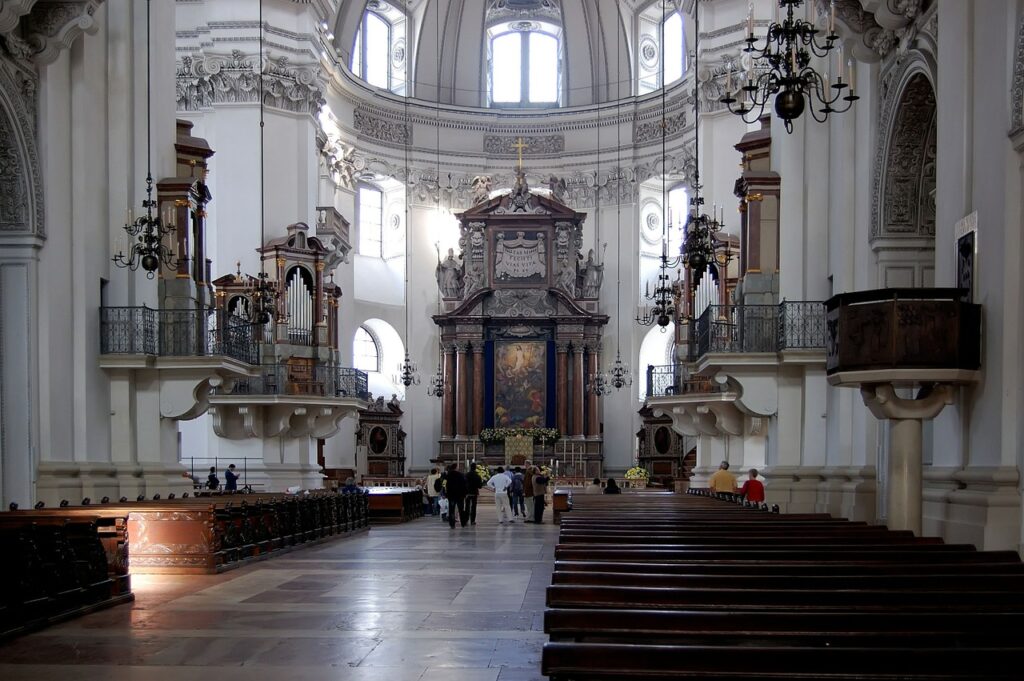
Many attractions are free charge of charge or a minimal fee. Closer to our hotel and in close proximity to St. Peter’s Abbey is the Salzburg Cathedral recognized as a UNESCO site in 1997. Considered the city’s most significant landmark, this basilica was founded in 774 by Irish priest, St. Rupert, nearly a century later than St. Peter’s. The cathedral’s intricate paintings and sculptures, its 232 foot dome, and the ornate baptismal font at which the infant Mozart was baptized are some of the impressive features which draw visitors worldwide. The “Hoforgel” the organ which Mozart frequently played, is located on the southeast side of the church.
Ravaged numerous times by fire and age, a more modern version of the basilica was constructed in 1628, but destroyed by an allied bomb during World War II. The present structure dates from 1959. As of July 2019, the cathedral had no entrance fee with visiting hours varying. During our spring visit it is open Monday through Saturday from 8:00 am to 7:00 pm.
St. Sebastian Cemetery and its Window into the Past
Across the bridge that spans the River Salzach closest to our hotel is Salzburg’s Tasty Donuts, a bakery much touted by several people we traveled with previously. I am noting this spot as a landmark because a few minutes walk past Tasty Donuts is the smaller but equally reverenced St. Sebastian Church. It’s original structure was built between 1505 and 1510. When it fell into disrepair, it was rebuilt in the baroque style of the 18th century. Art historians note its unique gate, rococo portico, and beautiful sculptures that adorn the high alter. However, it’s the cemetery beyond that has captured many travelers’ attention.

St. Sebastian’s neatly maintained cemetery is a peaceful last resting place of many prominent “Salzburgians” including Mozart’s father Leopold (1719- 1787), his wife Constance (1762 – 1842), and the father of modern medicine, Paracelsus (1493 – 1541). But, the source of this cemetery’s fascination is the haunting artwork of many of the older tombstones, reflecting an earlier time when the grim reality of death had a constant presence. When the first people were laid to rest in this cemetery in the early 16th century, medical practices were primitive, the childhood mortality rate was 50% and the average European didn’t live beyond the age of 40. Salzburg like many other places in Europe was significantly impacted by waves of the bubonic plague up into the mid 17th century. The beautiful but disturbing artistry of many of the tombstones borders on the macabre and the symbolic images of death is a common theme.
Although it may seem morbid to go out of our way for an hour to visit such a place, these graves with their unsettling images and sad inscriptions are a sobering reminder of what generations before us endured.
Other Places of Interest for a Minimal Fee
Next to our hotel is Mozart’s birthplace, the city’s most famous museum with an entrance fee of 10 Euros per person. The composer was born in this house in 1756 and lived here to adulthood. It was his family’s home for 27 years.
Next to St. Peter’s Abbey is the Festungsbahn, a cable car that will take you to the Castle Hohensalzburg Fortress above Salzburg with an entrance fee of 12 Euros.
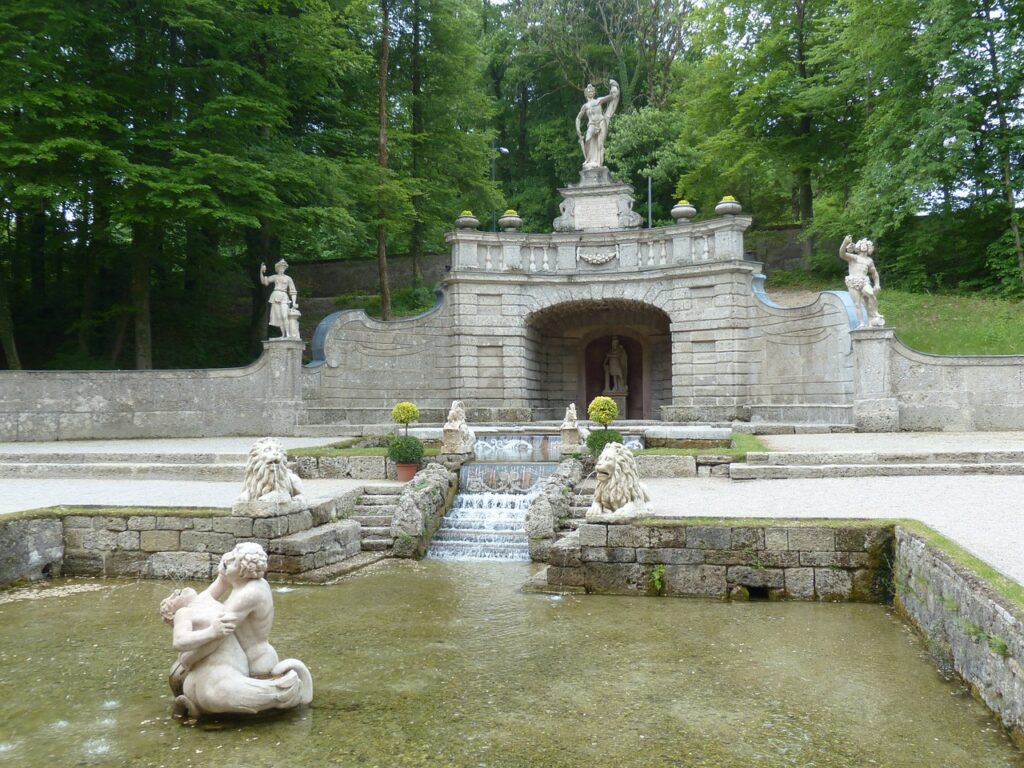
And for 13.50 Euro, you can visit one of the most curious places in Salzburg, Schloss Hellbrune, the day palace of Archbishop Marcus Sitticus who constructed the structure in 1619 as a place to spend the hot summer hours. Built over a spring, the palace has beautiful fountains and grotto with a number of primitive devices designed by the archbishop to spray his unsuspecting guests with blasts of water.
Depending on your choice of attractions, it may be in your best entrance to walk a block to Mozart Square and purchase the Salzburg Card for 27 Euro which provides entrance to 12 attractions and more.
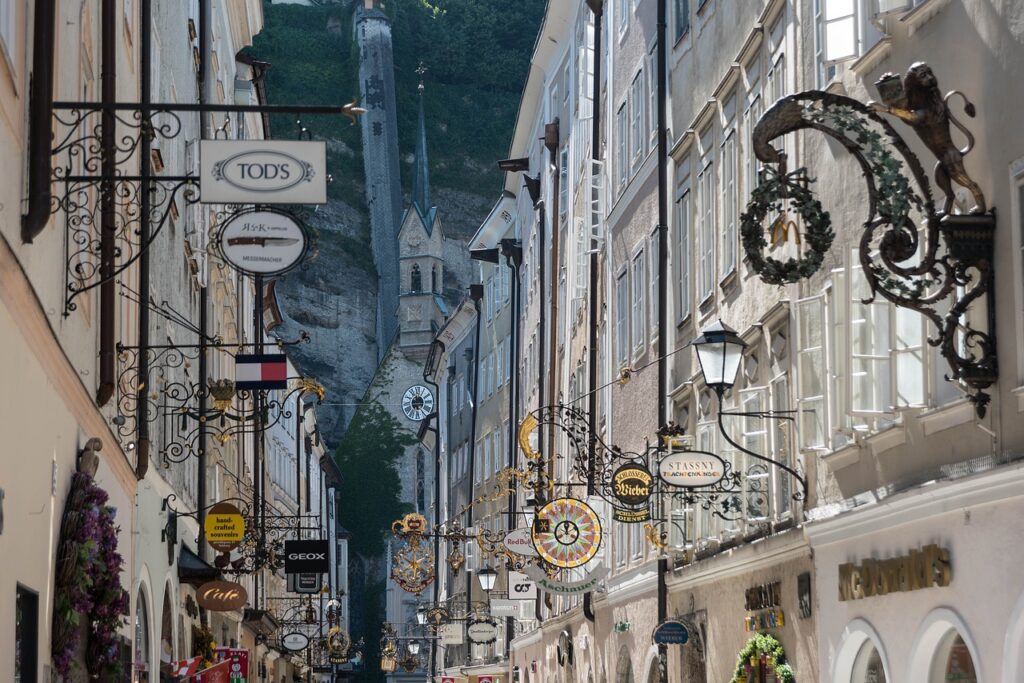
Another option is to join John and me for a half day visit to the Eagle’s Nest, Hitler’s mountain retreat, high in the alps and approximately 50 minutes from Salzburg. The Viator tour currently runs $67 a person. We’ll be back at our hotel by 1:30 with time left to take in other attractions.
Day 10: On to Padua, with a lunch stop at Lake Bled, Slovenia.
We’ll leave our hotel at 8:00 am after an early breakfast for a “new adventure.” John nor I have been to Slovenia or Padua although we’ve traveled through Italy.
We have poured over the map, located some essential rest stops, and our route has been approved through City Tours Buses–our coach company. Apparently it’s a common cycling route. According to Google, the travel time for today’s route is right at 6 hours, but we’ll add an hour for the twists and turns in the road. This day will be our longest en route as we travel through the Italian and Julian Alps to our lunch stop in Bled, Slovenia, at the halfway point. Our evening destination is the Majestic Toscanelli Hotel in Padua where we will arrive at approximately 6:30 pm. (If you are planning on a day of walking in Venice the following day, this day’s coach ride is a good opportunity to rest.)

We have heard multiple times from other travelers that Slovenia (and Croatia) are among the most beautiful countries in the world. This seems to be true judging from a quick perusal of Trip Advisor reviews from the last few weeks. A recent article by Treksplorer journalist Ryan O’Rourke also seems to confirm this.
We’ll arrive in Bled approximately noon with just two short hours to absorb the experience this region has to offer. This slavic town is situated on the shores of Lake Bled in the upper Carniolan region of Slovenia and dates back to as early as 800 A.D. A popular tourist destination, Trip Advisor notes a number of restaurants and souvenir shops. I have counted at least 20 of each.
If you are interested in learning more of Bled’s history, you can walk from our mini-buses’ parking spot about 6/10 of a mile up an incline to Castle Bled, dating to 1011 and the oldest castle in Slovenia. The castle has several tourist shops and a small museum with an entrance fee of 11 Euro.
Or, it’s possible to hire a Pletna, a gondola, for a short ride to Bled island in the middle of the lake and visit the Pilgrimage Church of the Assumption of Mary which dates to the 15th century. The church contains the Bell of Wishes made by Padua’s Francesco Patavino. Legends hold that if you ring the bell and make one wish, that wish will come true, providing you don’t wish for material wealth.
Couples may also be blessed with good luck if the husband carries his wife up the church’s 99 steps, providing she stays silent until they arrive at the top.
A 40-minute ound trip on a Pletna costs approximately 12 Euro. Add to that a 30-minute visit on the island before returning to the lake’s shore. The entrance to the church is 6 Euro. The island also has a Cafe, a confectionary, and a gift shop.
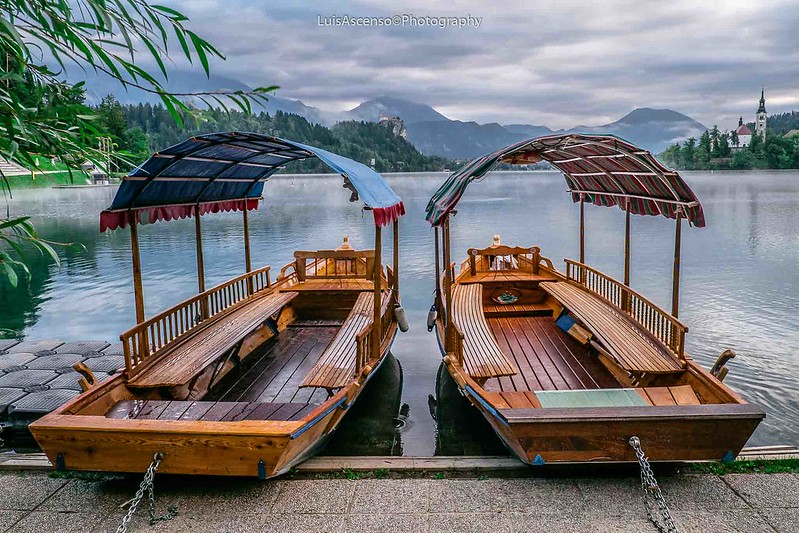
We’ll leave Bled behind at 2:00 pm for the final 3.5 hour leg of our journey to Padua, Italy, with a couple of rest stops in between, possible one outside of Ljubljana, Slovenia.
An evening in Padua? We can rely on the good reviews of Trip Advisor for the highly recommended and reasonably priced restaurants near our hotel. As Padua is not a common American tourist destination, we should probably prepare ourselves for an authentic immersion into the Italian culture–the very best kind.
Day 11, Padua Or Venice?
Just as Greenwich is a convenient vantage point from which to explore London, our research suggests that Padua is a similar sweet spot to explore Venice–but Padua has many of its own attractions.

Travel expert Rick Steves notes in his blog and video that he discovered the beauty and intrigue of Padua by accident because the hotels in Venice were all booked. Our hotel, the Majestic Toscanelli is located in the center of the city’s old town within quick walking distance of Padua’s most prominent features.
Once again, we have never stayed at the Majestic, but excellent customer reviews on multiple sites and prompt and professional correspondence from the hotel staff helped us make an easy choice among several hotels.
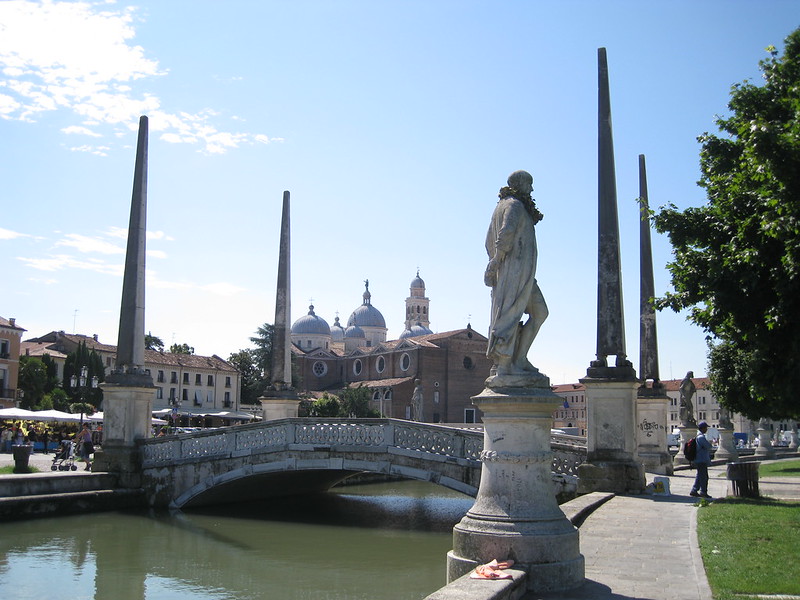
This longer video of Padua’s attractions and countless blogs make numerous recommendations for a day of sight-seeing in this ancient Roman city including the Prato de Valle, one of the most beautiful piazzas in Europe, and the Scrovegni Chapel, all a close stroll from our hotel.

Trip Advisor and other travel websites list numerous free attractions in Padua.
The Palazza Della Ragione, a medieval townhall dating to the 11th century is directly behind our hotel. Its name translates to the palace of reason. Its ground floor has been a marketplace for over eight centuries and containing over 50 artisan shops and delis. The upper floor is considered an “architectural wonder,” and has the largest roof in Europe not supported by columns. This hall, adorned with beautiful frescoes, served as an assembly hall until the 18th century. It is among the largest medieval town halls in the world.
Approximately one half mile walk from the hotel is the UNESCO World Heritage Site, the Orto Botanico, the world’s first botanical garden laid out in 1545.
The 14th century commissioned Fresco, The Last Judgment located in the chapel is considered one of the most important in western art. A 15-minute viewing of the Fresco requires a reservation and a fee of app. $21, but this fee also allows entrance into the City Museum and the Zuckermann Palace. Or, you can browse the lively open air markets of Padua, a common staple for 800 years.
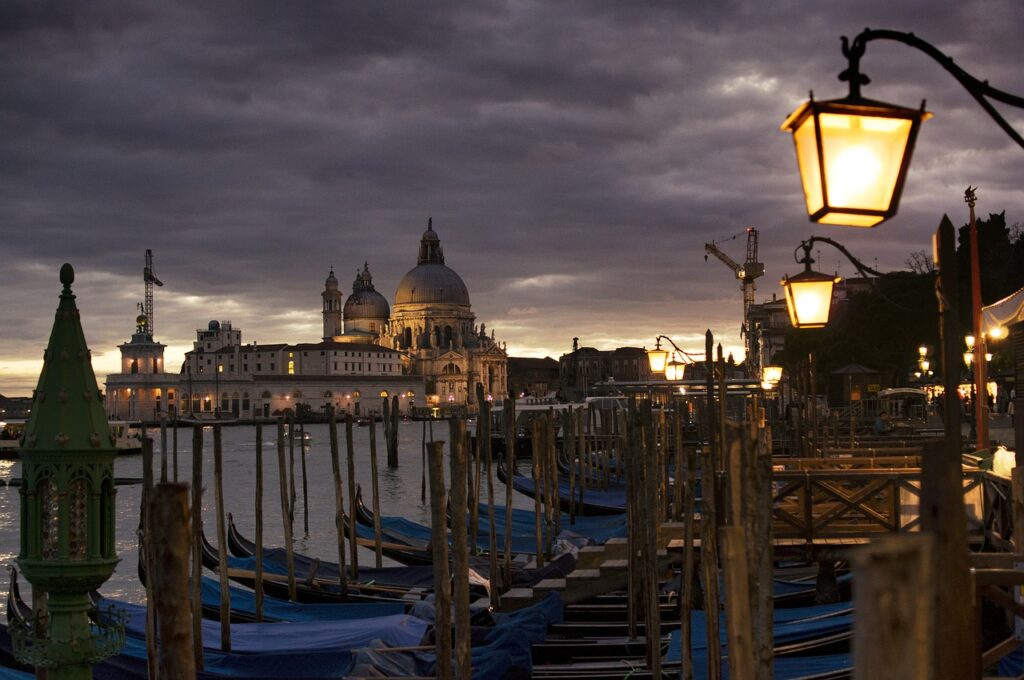
Of course, you may be more interested in the easy access Padua provides to the marvel of Venice, noted as a UNESCO World Heritage Site for its canals. The island city is just a 25-minute train ride round trip for $10 to $18 depending on the time of day. If you are up for a day of walking, this is a golden opportunity to see a city that will undoubtedly be uninhabitable by the time our grandchildren are our age. Important Note: to save time, purchase a roundtrip ticket and choose Venice Santa Lucia (the island) rather than Venice Mestre (the mainland).
The history of Venice! The beauty of Venice! The shopping in Venice! It’s hard to capture in words.
The Padua train station is approximately a mile walk down Corso Guiseppe Garibaldi street, so it’s better to have our hotel call for a taxi and hail one from the train station on our return trip. Currently, cab fare between 6 am and 10 pm runs 6 Euro for the minimum fee and 1.50 Euro per mile. One cab for four people will run about $2.50 per person including a tip.
Day 12, Train ride through the Italian and Swiss Alps To Zurich

On this day we begin the final leg of our trip–our journey to Zurich, Switzerland, through the alps. After hours of research and scouring the current travel forums, it seems the most enjoyable and convenient travel mode is by train. Padua to Zurich by rail includes the Gotthard Pass, one of the most scenic areas of the alps.
Although we have the option of a direct six hour route to Zurich from Padua with no transfers departing at 3:45 pm, this decision may invite trouble. The later departure means leaving the Hotel Toscanelli at 11 am and milling about the city of Padua for several hours with our luggage in tow. Italy is notorious for its throngs of friendly pickpockets. In fact, 12 middle-aged Americans walking the streets pulling our luggage behind us? Easy targets! In addition, if we travel in the later afternoon, nightfall will prevent us from seeing the most scenic part of the alps.
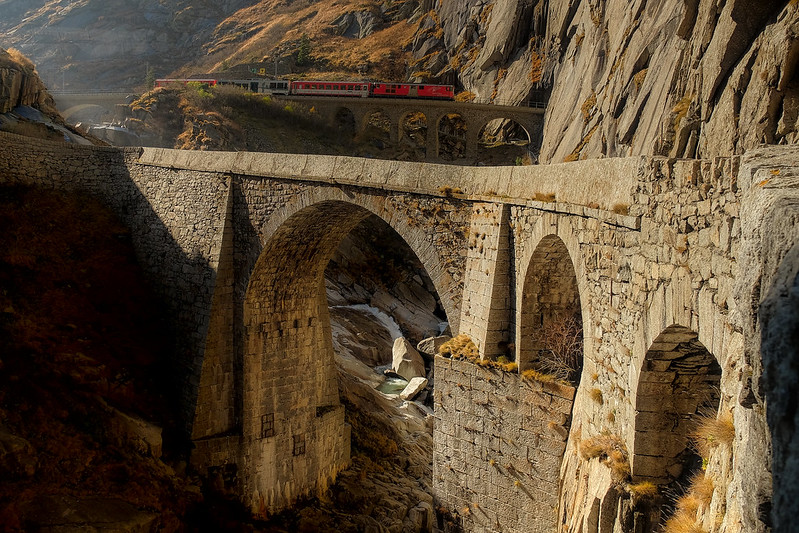
Although we will have an hour layover in Milan, an early departure for Zurich is the better decision. We’ll order several taxis to pick us up at 8:00 am from our hotel and take us the short distance to the station for one of two departures between 9 and 10:00 am. We will arrive in Milan Central about noon with an hour plus layover and an arrival in Zurich, before 5 pm.
And by the way, I’ve spent hours researching the most cost-efficient means for booking train tickets. I’ve discovered Trainline has the most competitive ticket rates and a user-friendly platform for navigating foreign train travel. Immediately after purchase, you receive your tickets via email and you can download them to Trainline’s handy app.
Although John and I have traveled through Switzerland, we have never been to Zurich; however, with the help of Rick Steves and some other travel gurus, I’m fairly confident our stay in Zurich will be a nice conclusion for our two-week trip.
Our evening destination is the renowned 4-Star Central Plaza Hotel, an establishment that has led the standard for Zurich’s hotel industry since 1883. The hotel is visible from the front entrance of the station and less than a five-minute walk. With the Central Plaza as our conveniently located headquarters, our day in Zurich will have many prospects.
When we arrive that evening, many shops in Zurich will be open until 8 pm and there are many possibilities for an evening bite to eat including restaurants and cafes at the train station. A bit of research is important to avoid a pricey dinner, but there are a number of affordable eateries like the Sternen Grill up the street from our hotel.
Day 13, A Free Day in Zurich
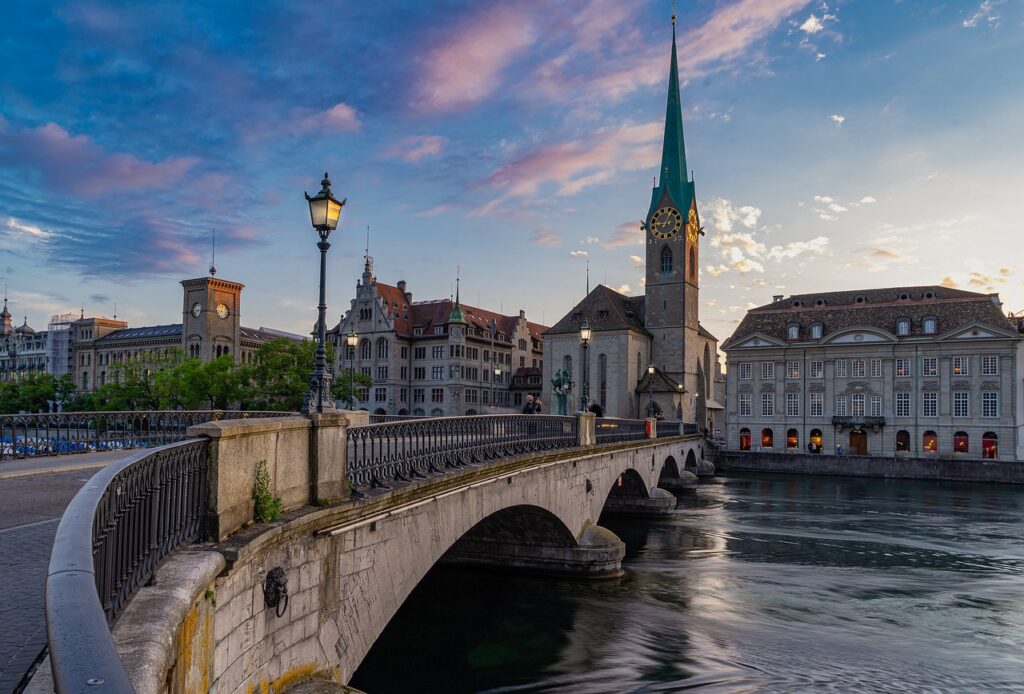
Zurich is located in a spectacular setting at the tip of Lake Zurich surrounded by snow-capped alps–a place of beauty with history dating back to pre-Roman times. It is the capitol of Switzerland and its economic hub.
Although our final full day in Europe lands on a Sunday when many shops are closed, Zurich still affords many options for a lovely and engaging day. Zurich is considered one of the most walkable cities in Europe. On Sundays at 11:00 am, the Credit Suisse on the Paradeplatz, offers several free walking tours with a knowledgeable guide including this historical tour or this tour of Old Town. This insightful video also provides an indepth view of what this city has to offer.

In particular, our day in Zurich should begin with a walk south toward the Lake through Aldstadt. If you step out of the front doors of our hotel you’ll be footsteps from the Limmatquai, Zurich’s promenade along the Limmat River. Within minutes you’ll arrive at Munsterhoff, a medieval town square in Zurich’s Aldstadt which includes Grossmunster Church, constructed in the 12th century.
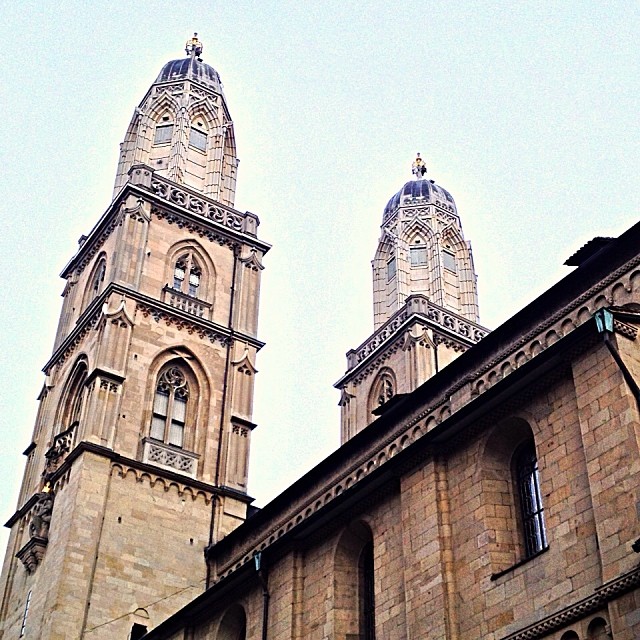
Of particular interest and central to the Protestant heritage many of us share is Zurich’s involvement in the Protestant Reformation, the Anabaptist movement, and the birth of the Swiss Brethren, inspired by 16th century leader Ulrich Zwingli. The Grossmunster Church played a significant role in these movements which led to the persecution, torture and execution of thousands across Europe. Founded by Charlemagne, its architecture reflects the Romanesque and Gothic eras in which its construction occurred. From its crypt to its stained glass windows and two towering spires which offer a panoramic view of Zurich, its one of the most popular attractions in the city. Entrance is free with an app. 5 Franc fee to climb one of its towers. In addition, this downloadable app provides a free walking tour of the religious highlights of the city.
Several pedestrian walkways bridge the gap across the Limmat. The walkway next to Grossmunster Church is the easiest means to access Fraumunster Church. This church dates to the 9th century but is noted today for its five spectacular glass windows created in the 1960s by artist Marc Chagall.
From Fraumunster you can continue south to the lake or walk north up the Bahnhofstrasse, a boulevard of over 90 stores in one of the most famous shopping districts in the world. Cartier, Tiffany & Co, and Longchamp Paris are only a few of the many stores located along this street.
CNN recently noted that Zurich is listed as one of the top ten expensive cities in the world in 2019 along with New York City and Los Angeles. However, several travel insiders offer some insight regarding the best places to get an inexpensive meal including Afar and the Scandinavian Traveler.
One factor working in our favor–the Swiss Franc is nearly par with the US Dollar at $1.02 at this writing, unlike the other currency rates of exchange we have encountered on this trip–Great Britain Pound and the Euro.
And, on that note, if you’ve never found a moment to shop on Day 13 of our trip, you can visit Shopville, the many stores in Zurich’s train station footsteps from our hotel. This shopping area’s motto is “Everything for your daily needs. 365 days a year. From early till late.”
Day 14, Homeward Bound
Our final day has arrived and it’s time to return to the United States.
Although our flight home doesn’t leave until 11:45 am, international flights require passengers to arrive at the hotel three hours in advance. For that reason, our transfer coach will pick us up at the hotel at 7:30 AM for the half hour commute to Zurich International Airport.
With the exception of customs, traveling home will be relatively easy. After all, we’re traveling six hours back in time. When we land in the United States, it will be a mere 3:00 in the afternoon–but 9:00 pm Switzerland time. And, we’ll probably coast on the exhilaration of being back on our home turf into the wee hours of the night when we finally arrive safe and surrender to the comfort of our own beds–our trip a pleasant memory.
But then, beware. The following day and probably every day in the week that follows–everything you heard about jet lag is true.

A special thanks to the vast community of photographers on Flickr and Pixabay willing to share their work in Creative Commons. They’re far better picture takers than we are.
Bosman, Suzanne. “‘Not One Picture Shall Leave this Island:’ How Churchill Saved the National Gallery.” The Telegraph, 6 March 2018, retrieved on 9 January 2020 from https://www.telegraph.co.uk/art/what-to-see/not-one-picture-shall-leave-island-winston-churchill-saved-national/

